Samsung Electronics Co SP10 Notebook PC User Manual manual English 0328
Samsung Electronics Co Ltd Notebook PC manual English 0328
Contents
- 1. Users Manual 1
- 2. Users Manual 2
Users Manual 1

Notices i
Notices
No part of this publication may be reproduced, stored in a retrieval system, or
transmitted, in any form or by any means, mechanical photocopying, recording or
otherwise, without the prior written permission of the manufacturer.
The information within this manual is subject to change without notice.
The manufacturer shall not be held liable for technical or editorial errors or omissions
contained in herein; nor for incidental or consequential damages resulting from the
furnishing, performance or use of this material.
Microsoft Windows is a registered trademark of the Microsoft Corporation.
Product names mentioned herein are for identification purposes only, and may be
trademarks and/or registered trademarks of their respective companies.
Macrovision Statement
If your computer has a DVD drive and an analog TV Out port, the following
paragraph applies:
This product incorporates copyright protection technology that is protected by method
claims of certain U.S. patents and other intellectual property rights owned by
Macrovision Corporation and other rights owners. Use of this copyright protection
technology must be authorized by Macrovision Corporation, and is intended for home
and other limited viewing uses only unless otherwise authorized by Macrovision
Corporation. Reverse engineering or disassembly is prohibited.
Copyright 2002 All rights are reserved
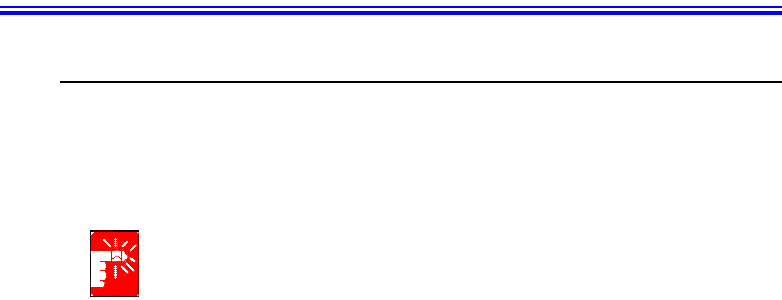
ii Users Manual
Important Safety Information
Safety Instructions
Your system is designed and tested to meet the latest standards for safety of
information technology equipment. However, to ensure safe use of this product, it is
important that the safety instructions marked on the product and in the documentation
are followed.
Always follow these instructions to help guard against personal injury and
damage to your system.
i
Setting Up your System
•Read and follow all instructions marked on the product and in the
documentation before you operate your system. Retain all safety and operating
instructions for future use.
•Do not use this product near water or a heat source such as a radiator.
•Set up the system on a stable work surface.
•The product should be operated only with the type of power source indicated on
the rating label.
•Ensure that the electrical outlet you are using to power your equipment is easily
accessible in case of fire or short circuit.
•If your computer has a voltage selector switch, make sure that the switch is in
the proper position for your area.
•Openings in the computer case are provided for ventilation. Do not block or
cover these openings. Make sure you provide adequate space, at least 6 inches
(15 cm), around the system for ventilation when you set up your work area.
Never insert objects of any kind into the computer ventilation openings.
•Ensure that the fan vents on the bottom of the casing are clear at all times. Do
not place the computer on a soft surface, doing so will block the bottom vents.
•If you use an extension cord with this system, make sure that the total ampere
rating on the products plugged into the extension cord does not exceed the
extension cord ampere rating.

Important Safety Information iii
Care During Use
•Do not walk on the power cord or allow anything to rest on it.
•Do not spill anything on the system. The best way to avoid spills is to not eat or
drink near your system.
•Some products have a replaceable CMOS battery on the system board. There is
a danger of explosion if the CMOS battery is replaced incorrectly. Replace the
battery with the same or equivalent type recommended by the manufacturer.
Dispose of batteries according to the manufacturer’s instructions. If the CMOS
battery requires replacement insure that a qualified technician performs the task
•When the computer is turned off, a small amount of electrical current still flows
through the computer. To avoid electrical shock, always unplug all power
cables, remove the battery and modem cables from the wall outlets before
cleaning the system.
•Unplug the system from the wall outlet and refer servicing to qualified
personnel if:
– The power cord or plug is damaged.
– Liquid has been spilled into the system.
– The system does not operate properly when the operating instructions are
followed.
– The system was dropped or the casing is damaged.
– The system performance changes.
Replacement Parts and Accessories
Use only replacement parts and accessories recommended by manufacturer.
To reduce the risk of fire, use only No. 26 AWG or larger telecommunications
line cord.
Writtenby: Daryl L. Osden
Do not use this product in areas classified as hazardous. Such areas include
patient care areas of medical and dental facilities, oxygen rich environments,
or industrial areas.

iv Users Manual
Battery Disposal
Do not put rechargeable batteries or products powered by non-removable
rechargeable batteries in the garbage.
Contact the Samsung Helpline for information on how to dispose of batteries that you
cannot use or recharge any longer.
Follow all local regulations when disposing of old batteries.

Regulatory Compliance Statements v
Regulatory Compliance Statements
Wireless Guidance
Low power, Radio LAN type devices (radio frequency (RF) wireless communication
devices), operating in the 2.4 GHz Band, may be present (embedded) in your notebook
system. The following section is a general overview of considerations while operating
a wireless device.
Additional limitations, cautions, and concerns for specific countries are listed in the
specific country sections (or country group sections). The wireless devices in your
system are only qualified for use in the countries identified by the Radio Approval
Marks on the system rating label. If the country you will be using the wireless device
in, is not listed, please contact your local Radio Approval agency for requirements.
Wireless devices are closely regulated and use may not be allowed.
The power output of the wireless device or devices that may be embedded in your
notebook is well below the RF exposure limits as known at this time. Because the
wireless devices (which may be embedded into your notebook) emit less energy than
is allowed in radio frequency safety standards and recommendations, manufacturer
believes these devices are safe for use. Regardless of the power levels, care should be
taken to minimize human contact during normal operation.
As a general guideline, a separation of 20 cm (8 inches) between the wireless device
and the body, for use of a wireless device near the body (this does not include
extremities) is typical. This device should be used more than 20 cm (8 inches) from the
body when wireless devices are on and transmitting.
Radio frequency wireless communication can interfere with equipment on
commercial aircraft. Current aviation regulations require wireless devices to be
turned off while traveling in an airplane. 802.11B (also known as wireless
Ethernet or Wifi) and Bluetooth communication devices are examples of
devices that provide wireless communication.
S
ome circumstances require restrictions on wireless devices. Examples of common
r
estrictions are listed below:
This transmitter must not be collocated or operation in conjunction with any other
antenna or transmitter.
S
ome circumstances require restrictions on wireless devices. Examples of common
r
estrictions are listed below:

vi Users Manual
In environments where the risk of interference to other devices or services is
harmful or perceived as harmful, the option to use a wireless device may be
restricted or eliminated. Airports, Hospitals, and Oxygen or flammable gas
laden atmospheres are limited examples where use of wireless devices may
be restricted or eliminated. When in environments where you are uncertain of
the sanction to use wireless devices, ask the applicable authority for
authorization prior to use or turning on the wireless device.
Every country has different restrictions on the use of wireless devices. Since
your system is equipped with a wireless device, when traveling between
countries with your system, check with the local Radio Approval authorities
prior to any move or trip for any restrictions on the use of a wireless device in
the destination country.
If your system came equipped with an internal embedded wireless device, do
not operate the wireless device unless all covers and shields are in place and
the system is fully assembled.
Wireless devices are not user serviceable. Do not modify them in any way.
Modification to a wireless device will void the authorization to use it. Please
contact manufacturer for service.
Only use drivers approved for the country in which the device will be used. See
the manufacturer System Restoration Kit, or contact manufacturer Technical
Support for additional information.
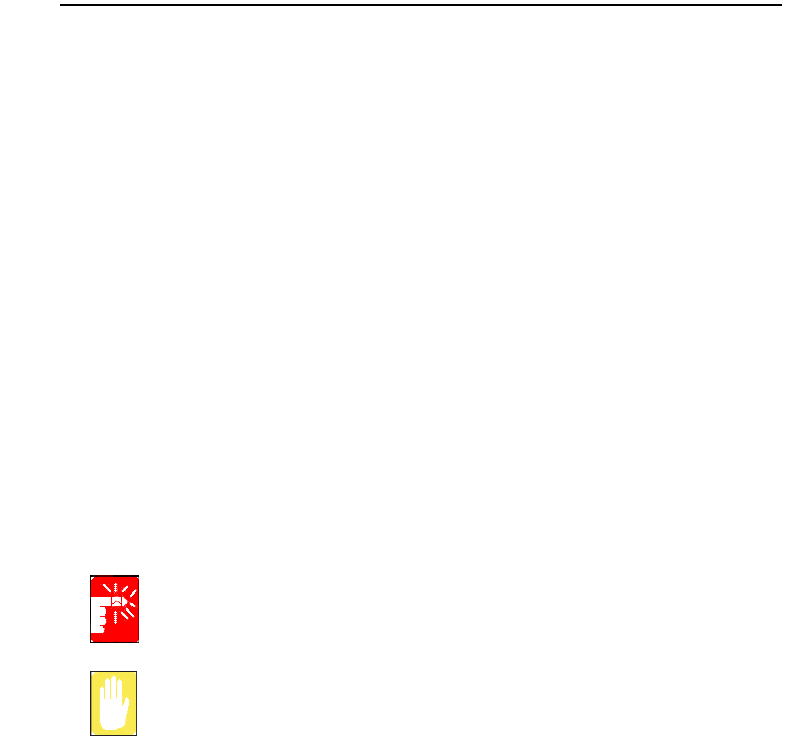
Regulatory Compliance Statements vii
United States of America
Federal Communications Commission (FCC)
Intentional emitter per FCC Part 15
Low power, Radio LAN type devices (radio frequency (RF) wireless communication
devices), operating in the 2.4 GHz Band, may be present (embedded) in your notebook
system. This section is only applicable if these devices are present. Refer to the system
label to verify the presence of wireless devices.
Wireless devices that may be in your system are only qualified for use in the United
States of America if an FCC ID number is on the system label.
The FCC has set a general guideline of 20 cm (8 inches) separation between the device
and the body, for use of a wireless device near the body (this does not include
extremities). This device should be used more than 20 cm (8 inches) from the body
when wireless devices are on. The power output of the wireless device (or devices),
which may be embedded in your notebook, is well below the RF exposure limits as set
by the FCC.
This transmitter must not be collocated or operation in conjunction with any other
antenna or transmitter.
Wireless devices are not user serviceable. Do not modify them in any way.
Modification to a wireless device will void the authorization to use it. Contact
manufacturer for service.
FCC Statement for Wireless LAN use:
“While installing and operating this transmitter and antenna combination the
radio frequency exposure limit of 1mW/cm2 may be exceeded at distances
close to the antenna installed. Therefore, the user must maintain a minimum
distance of 20cm from the antenna at all times. This device can not be
colocated with another transmitter and transmitting antenna.”
Unintentional Emitter per FCC Part 15
This device complies with Part 15 of the FCC Rules. Operation is subject to the
following two conditions:(1) this device may not cause harmful interference, and (2)
this device must accept any interference received, including interference that may
cause undesired operation.
O
peration of this device is subject to the following two conditions: (1) This device may
n
ot cause harmful interference, and (2) this device must accept any interference
r
eceived, including interference that may cause undesired operation of the device.

viii Users Manual
Writtenby: Daryl L. Osden
This equipment has been tested and found to comply with the limits for a Class
B digital device pursuant to Part 15 of the FCC Rules. These limits are
designed to provide reasonable protection against harmful interference in a
residential installation. This equipment generate uses and can radiate radio
frequency energy and if not installed and used in accordance with the
instructions may cause harmful interference will not occur in a particular
installation. If this equipment does cause harmful interference to radio or
television reception, which can be determined by turning the equipment off
and on, the user is encouraged to try to correct the interference by one or more
of the following measures:
•Reorient or relocate the receiving antenna.
•Increase the separation between the equipment and receiver.
•Connect the equipment into an outlet on a circuit different from that
to which the receiver is connected.
•Consult the dealer or an experienced radio/TV technician for help.
If necessary, the user should consult the dealer or an experienced radio/television
technician for additional suggestions. The user may find the following booklet helpful:
“Something About Interference.” This is available at FCC local regional offices. Our
company is not responsible for any radio or television interference caused by
unauthorized modifications of this equipment or the substitution or attachment of
connecting cables and equipment other than those specified by our company. The
correction will be the responsibility of the user. Use only shielded data cables with this
system.
Federal Communications Commission Part 68 Statement
This equipment compiles with part of the FCC rules. On the back of this equipment is
a label that contains, among other information, the FCC registration number and ringer
equivalence number (REN) for this equipment. If requested, this information must be
provided to the telephone company.
This equipment uses the following USOC jacks : RJ11C
An FCC compliant telephone cord and modular plug is provided with this equipment.
This equipment is designed to be connected to the telephone network or promises
wiring using a compatible modular jack which is Part 68 compliant. See Installation
Instructions for details.
Regulatory Compliance Statements ix
The REN is used to determine the quantity of devices which may be connected to
telephone line. Excessive RENs on the telephone line may result in the devices not
ringing in response to an incoming call. In most, but not all areas, the sum of RENs
should not exceed five (5.0). To be certain of the number of devices that may be
connected to a line, as determined by total RENs, contact the local telephone company
to determine the maximum REN for the calling area.
If the terminal equipment causes harm to the telephone network, the Telephone
Company will notify you in advance that temporary discontinuance of service may be
required. But if advance notice is not practical, the telephone company will notify the
customer as soon as possible. Also, you will be advised of your right to file a complaint
with the FCC if you believe it is necessary.
The telephone company may make changes in its facilities, equipment, operations, or
procedures that could affect the operation of the equipment. If this happens, the
telephone company will provide advanced notice in order for you to make necessary
modifications to maintain uninterrupted service.
If trouble is experienced with this equipment (Modem) for repair or warranty
information, please contact your local distributor. If the equipment is causing harm to
the telephone network, the telephone company may request that you disconnect the
equipment until the problem is resolved.
The user must use the accessories and cables supplied by the manufacturer to get
optimum performance from the product.
No repairs may be done by the customer.
This equipment cannot be used on public coin phone service provided by the telephone
company. Connection to party line service is subject to state tariffs.
The Telephone Consumer Protection Act of 1991 makes it unlawful for any person to
use a computer or other electronic device, including fax machines, to send any message
unless such message clearly contains in a margin at the top or bottom of each
transmitted page or on the first page of the transmission, the date and time it is sent and
an identification of the business or other entity, or other individual sending the message
and the telephone number of the sending machine or such business, other entity, or
individual. (The telephone number provided may not be any number for which charges
exceed local or long-distance transmission charges.)
In order to program this information into your fax machine, refer to your
communications software user manual.

x Users Manual
Canada
Industry Canada (IC)
Intentional Emitter per RSS 210
Low power, Radio LAN type devices (radio frequency (RF) wireless communication
devices), operating in the 2.4 GHz Band, may be present (embedded) in your notebook
system. This section is only applicable if these devices are present. Refer to the system
label to verify the presence of wireless devices.
Wireless devices that may be in your system are only qualified for use in Canada if an
Industry Canada ID number is on the system label.
As a general guideline, a separation of 20 cm (8 inches) between the wireless device
and the body, for use of a wireless device near the body (this does not include
extremities) is typical. This device should be used more than 20 cm (8 inches) from the
body when wireless devices are on.
The power output of the wireless device (or devices), which may be embedded in your
notebook, is well below the RF exposure limits as set by Industry Canada.
This transmitter must not be collocated or operation in conjunction with any other
antenna or transmitter.
To prevent radio interference to licensed service, this device is intended to be
operated indoors and away from windows to provide maximum shielding.
Equipment (or its transmit antenna) that is installed outdoors is subject to
licensing.
Wireless devices are not user serviceable. Do not modify them in any way.
Modification to a wireless device will void the authorization to use it. Contact
manufacturer for service.
Unintentional Emitter per ICES-003
This digital apparatus does not exceed the Class B limits for radio noise emissions from
digital apparatus as set out in the radio interference regulations of Industry Canada.
Le présent appareil numérique n’émet pas de bruits radioélectriques dépassant les
limitesapplicables aux appareils numériques de Classe B prescrites dans le règlement
sur le brouillage radioélectrique édicté par Industrie Canada.
O
peration of this device is subject to the following two conditions: (1) This device may
n
ot cause harmful interference, and (2) this device must accept any interference
r
eceived, including interference that may cause undesired operation of the device.

Regulatory Compliance Statements xi
European Union
The following information is only applicable to systems labeled with the CE mark .
European Directives
This Information Technology Equipment has been tested and found to comply with the
following European directives:
•EMC Directive 89/336/EEC with amending directives 92/31/EEC & 93/68/
EEC as per
– EN 55022 Class B
– EN 61000-3-2
– EN 61000-3-3
– EN 55024
•Low Voltage Directive (Safety) 73/23/EEC as per EN 60950(A1/A2/A3/A4/
A11)
•Radio and Telecom Terminal Equipment Directive 199/5/EC as per
– CTR21 (if fitted with a modem device)
– ETS 300 328 (if fitted with a 2.4 GHz band embedded wireless device)
– ETS 301 489-1 (if fitted with a 2.4 GHz band embedded wireless device)
– ETS 301 489-17 (if fitted with a 2.4 GHz band embedded wireless device)
European Radio Approval Information
(for products fitted with EU-approved radio devices)
This Product is a Notebook computer; low power, Radio LAN type devices (radio
frequency (RF) wireless communication devices), operating in the 2.4 GHz band, may
be present (embedded) in your notebook system which is intended for home or office
use. This section is only applicable if these devices are present. Refer to the system
label to verify the presence of wireless devices.
Wireless devices that may be in your system are only qualified for use in the European
Union or associated areas if a CE mark with a Notified Body Registration Number
and the Alert Symbol is on the system label.
The power output of the wireless device or devices that may be embedded in you
notebook is well below the RF exposure limits as set by the European Commission
through the R&TTE directive.

xii Users Manual
European States qualified under wireless approvals:
EU Austria, Belgium, Denmark, Finland, France (with frequency
restrictions), Germany, Greece, Ireland, Italy, Luxembourg, The
Netherlands, Portugal, Spain, Sweden and the United Kingdom.
Accept EU Iceland, Liechtenstein, Norway and Switzerland
European States with restrictions on use:
EU In France, the frequency range is restricted to 2446.5-2483.5 MHz for
devices above 10 mW transmitting power such as wireless LAN.
Accept EU No limitations at this time.
European Telecommunication Information
(for products fitted with EU-approved modems)
Marking by the symbol indicates compliance of this equipment to the Radio and
Telecom Terminal Equipment Directive 1999/5/EC. Such marking is indicative that
this equipment meets or exceeds the following technical standards:
CTR 21 – Attachment requirements for pan-European approval for connection to the
analogue Public Switched Telephone Networks (PSTNs) of TE (excluding TE
supporting voice telephony services) in which network addressing, if provided, is by
means of Dual Tone Multi-Frequency (DTMF) signaling.
Although this equipment can use either loop disconnect (pulse) or DTMF
(tone) signaling, only the performance of the DTMF signaling is subject to
regulatory requirements for correct operation. It is therefore strongly
recommended that the equipment is set to use DTMF signaling for access to
public or private emergency services. DTMF signaling also provides faster call
setup.
This equipment has been approved to Council Decision 98/482/EEC—“CTR 21” for
Pan-European single terminal connection to the Public Switched Telephone Network
(PSTN).
However, due to differences between the individual PSTNs provided in different
countries, the approval does not, of itself, give an unconditional assurance of
successful operation on every PSTN termination point. In the event of problems, you
should contact manufacturer Technical Support.
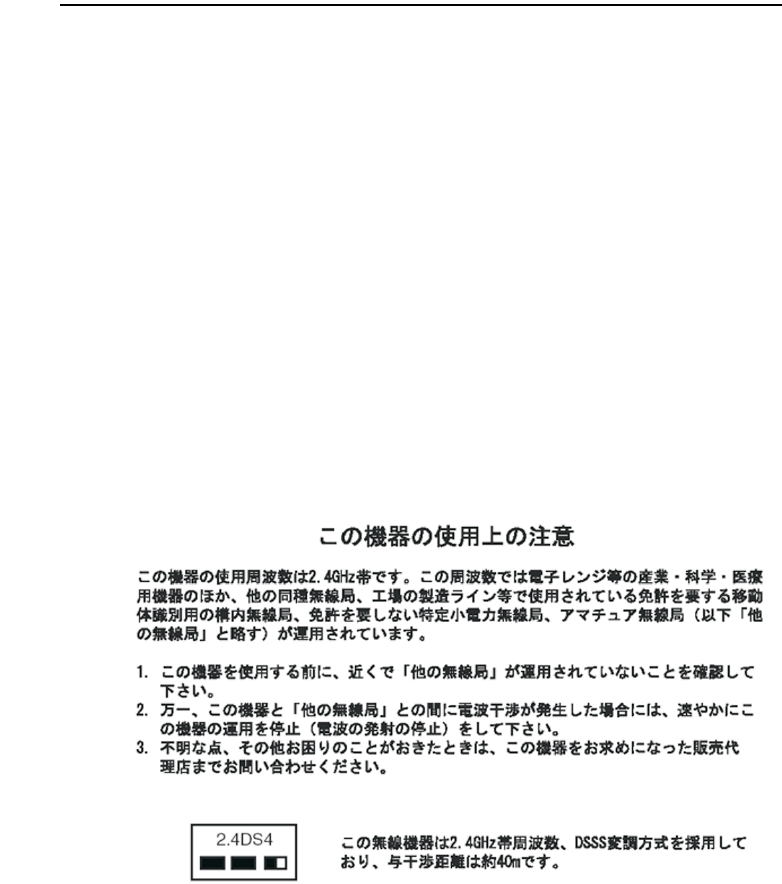
Regulatory Compliance Statements xiii
Japan
Wireless Devices
Low power, Radio LAN type devices (radio frequency (RF) wireless communication
devices), operating in the 2.4 GHz Band, may be present (embedded) in your notebook
system. This section is only applicable if these devices are present. Refer to the system
label to verify the presence of wireless devices.
Wireless devices that may be in your system are only qualified for use in Japan if a
TELEC ID is on the system label.
Operational guidelines for 2.4 GHz band wireless equipment (if equipped)
This equipment uses the 2.4 GHz ISM frequency band. The ISM band is the industrial,
scientific, and medical device band. Devices that might also use this band are
microwave ovens, other LAN devices, amateur radio stations, licensed premises radio
stations, and non-licensed specified low-power radio stations.
Prior to setting up your device:
1. Make sure that there are no other devices in your area using the same frequency
band.
2. Change the channel, location, or discontinue device use if you are interfering with
any other radio station.
3. Contact manufacturer if you have any problems with this device.

xiv Users Manual
VCCI Statement
This equipment is in the Class B category (Information Technology Equipment to be
used in a residential area or an adjacent area thereto) and conforms to the standards set
by the Voluntary Control Council for Interference by Information Technology
Equipment aimed at preventing radio interference in such residential areas. When used
near a radio or TV receiver, it may become the cause of radio interference. Read
instructions for correct handling.
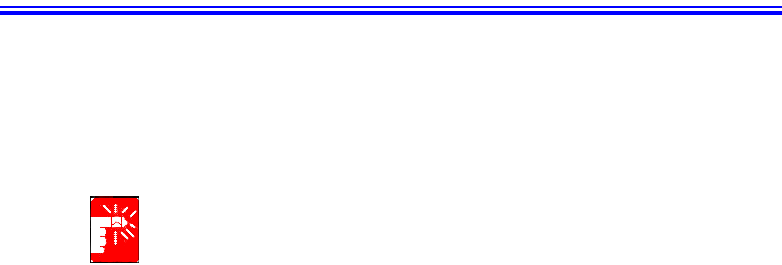
Laser Safety xv
Laser Safety
All systems equipped with CD or DVD drives comply with the appropriate safety
standards, including IEC 825. The laser devices in these components are classified as
“Class 1 Laser Products” under a US Department of Health and Human Services
(DHHS) Radiation Performance Standard. Should the unit ever need servicing, contact
an authorized service location.
Laser Safety Note:
Use of controls or adjustments or performance of procedures other than those
specified in this manual may result in hazardous radiation exposure. To
prevent exposure to laser beams, do not try to open the enclosure of a CD or
DVD drive.

xvi Users Manual
Power Cord Requirements
The power cord set (wall plug, cable and AC adapter plug) you received with your
computer meets the requirements for use in the country where you purchased your
equipment.
Power cord sets for use in other countries must meet the requirements of the country
where you use the computer. For more information on power cord set requirements,
contact your authorized dealer, reseller, or service provider.
General Requirements
The requirements listed below are applicable to all countries:
•The length of the power cord set must be at least 6.00 feet (1.8m) and a
maximum of 9.75 feet (3.0m).
•All power cord sets must be approved by an acceptable accredited agency
responsible for evaluation in the country where the power cord set will be used.
•The power cord set must have a minimum current capacity of 7 A and a
nominal voltage rating of 125 or 250 volts AC, as required by each country’s
power system.
•The appliance coupler must meet the mechanical configuration of an EN 60
320/IEC 320 Standard Sheet C13 connector, for mating with appliance inlet on
the computer.

Power Cord Requirements xvii
Country-Specific Power Cord Set Requirements
The requirements listed below are applicable to the specific country listed:
Writtenby: Daryl L. Osden
Notes:
1. Flexible cord must be Type HO5VV-F, 2-conductor, 1.0 mm² conductor
size. Power cord set fittings (appliance coupler and wall plug) must bear
the certification mark of the agency responsible for evaluation in the
country where it will be used.
2. Flexible cord must be Type SVT or equivalent, No.18 AWG. Wall plug must
be a two-pole grounding type.
3. Appliance coupler, flexible cord, and wall plug must bear a “T” mark and
registration number in accordance with the Japanese Dentori Law. Flexible
cord must be Type VCT or VCTF, 2-conductor, 0.75 mm² conductor size.
Wall plug must be a two-pole grounding type with a Japanese Industrial
Standard C8303 (15 A, 125V) configuration.
Country Accrediting
Agency
Applicable Note
Numbers
Australia EANSW 1
Austria OVE 1
Belgium CEBC 1
Canada CSA 2
Denmark DEMKO 1
Finland FIMKO 1
France UTE 1
Germany VDE 1
Italy IMQ 1
Japan JIS 3
The Netherlands KEMA 1
Norway NEMKO 1
Sweden SEMKO 1
Switzerland SEV 1
United Kingdom BSI 1
United States UL 2
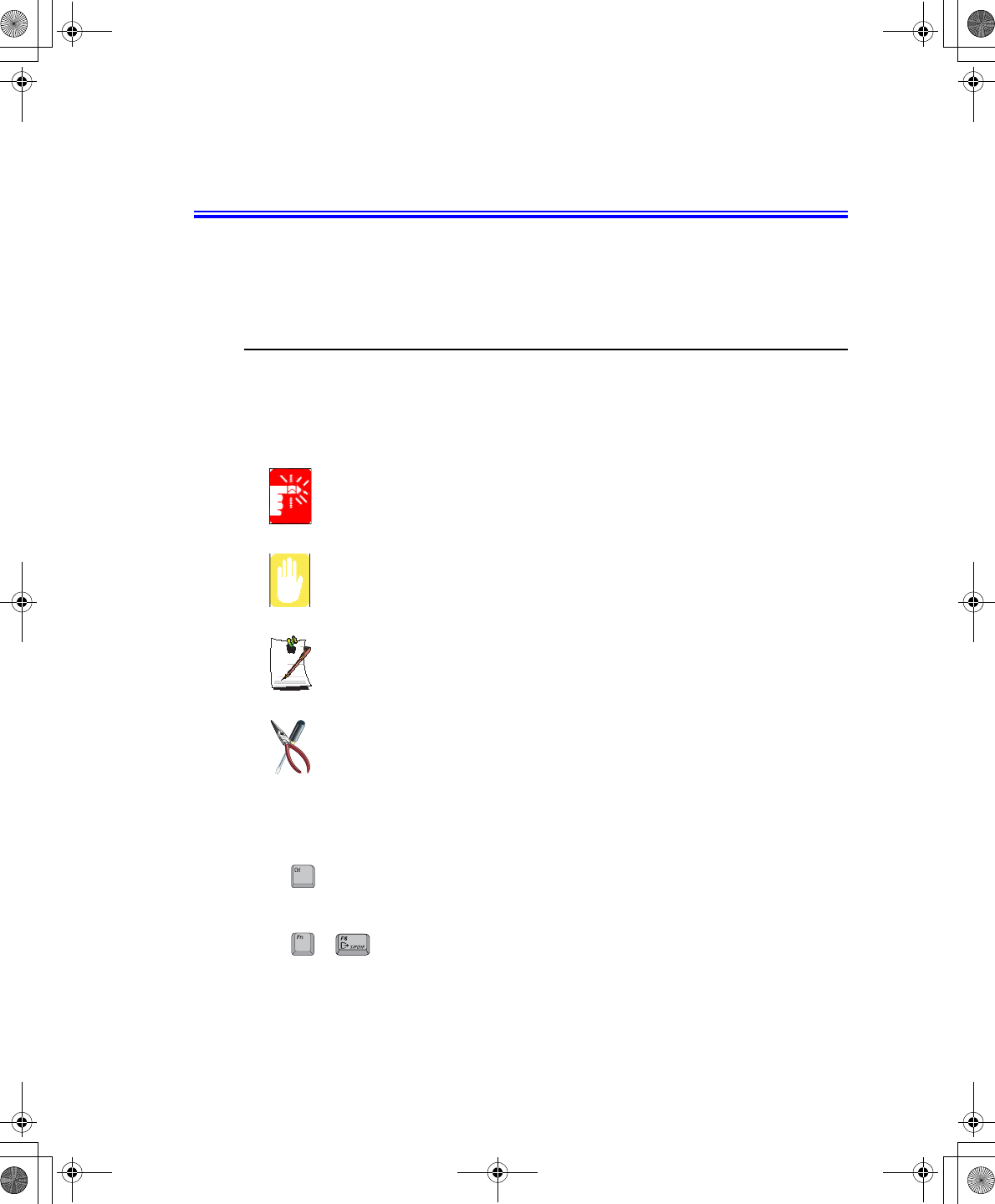
Using Your Documentation 1
Using Your Documentation
Congratulations on your purchase of a notebook computer with the Windows® XP
operating system. Whether you are new to using a portable computer or are an
experienced user, this user’s manual can help you get the most from your computer.
Manual Documentation Conventions
Information Icons
Three icons and their associated messages appear in this manual. The information
icons are placed before the step/information they apply to:
Warning:
Indicates the possibility of personal injury.
Caution:
Warns you of possible damage to equipment or data.
Note:
Informs you of special circumstances.
Technical Information:
Informs you of special requirements or limitations for use of item(s).
Keyboard Conventions
Keys that you need to press to perform certain functions are displayed in the manual
using a small graphic of the button. For example: <Ctrl>
or <Ctrl> indicates the control key (Ctrl on the keyboard).
If you need to press two keys at the same time, the key names are shown joined by a
plus sign. For example:
or <Fn+F8>
means that you should press the Fn key and hold it and then press the F8 key.
+
Taurus (Windows XP) - English.fm Page 1 Thursday, March 28, 2002 6:06 PM
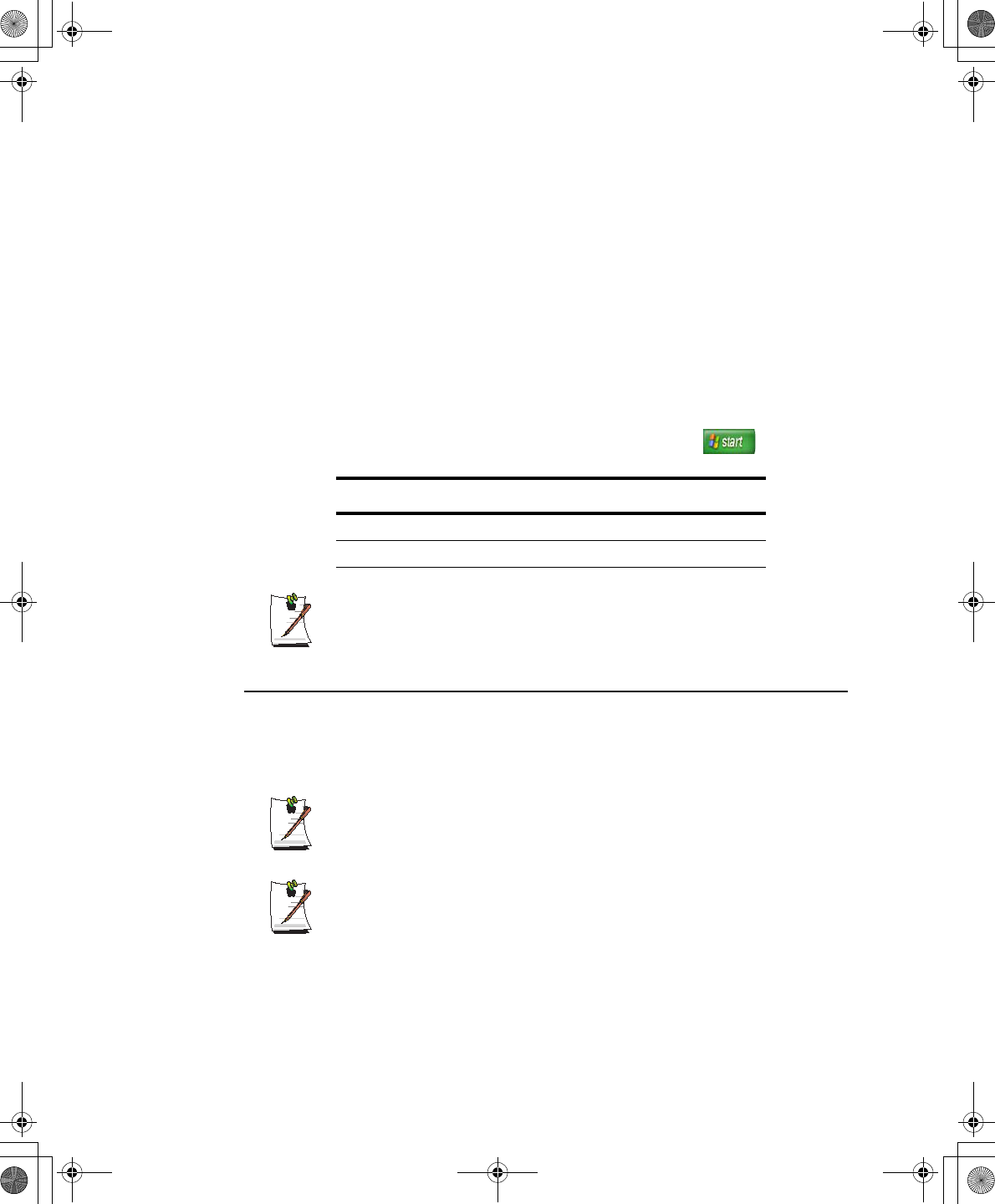
2 Users Manual
CD-ROM Device Naming Convention
In many installation programs you will have to get a program from the CD-ROM
device. The program installation sequence assumes that the CD is drive d:\, however
this is not always the case. The name of the CD-ROM drive is the letter following the
letter assigned to your last HDD. For instance, if you have one HDD with two
partitions, the HDD is drives C: and D: and the CD-ROM drive is then drive E.
Touchpad Conventions
You may be asked to click or double-click on items on the display screen. As a general
note the touchpad actions act much in the same way as a wheel mouse, any differences
are explained fully.
The object that needs to be clicked upon will be displayed in Bold text or shown in a
small figure such as the “Start Button” shown on the right =>.
Table 1. Touchpad Click Conventions
Windows Conventions:
Almost all “Windows” programs will display the name/function of a button or
icon if you place the touchpad pointer on the item you want information about.
Software User Documentation
Your computer is shipped from the factory with several software programs installed.
The software may include its own online or printed documentation. Refer to the
documentation or the Help options in the software for more information.
The figures and illustrations in this manual may not be identical to those on
your system.
General Icon Note:
Some of the Icons used in Windows XP may be placed on the taskbar by
selecting (ex: Place the volume icon in the taskbar) in the properties dialog
box.
Action Process
Click Depress the touchpad left button and release
Double-Click Quickly click the left touchpad button two times
Taurus (Windows XP) - English.fm Page 2 Thursday, March 28, 2002 6:06 PM
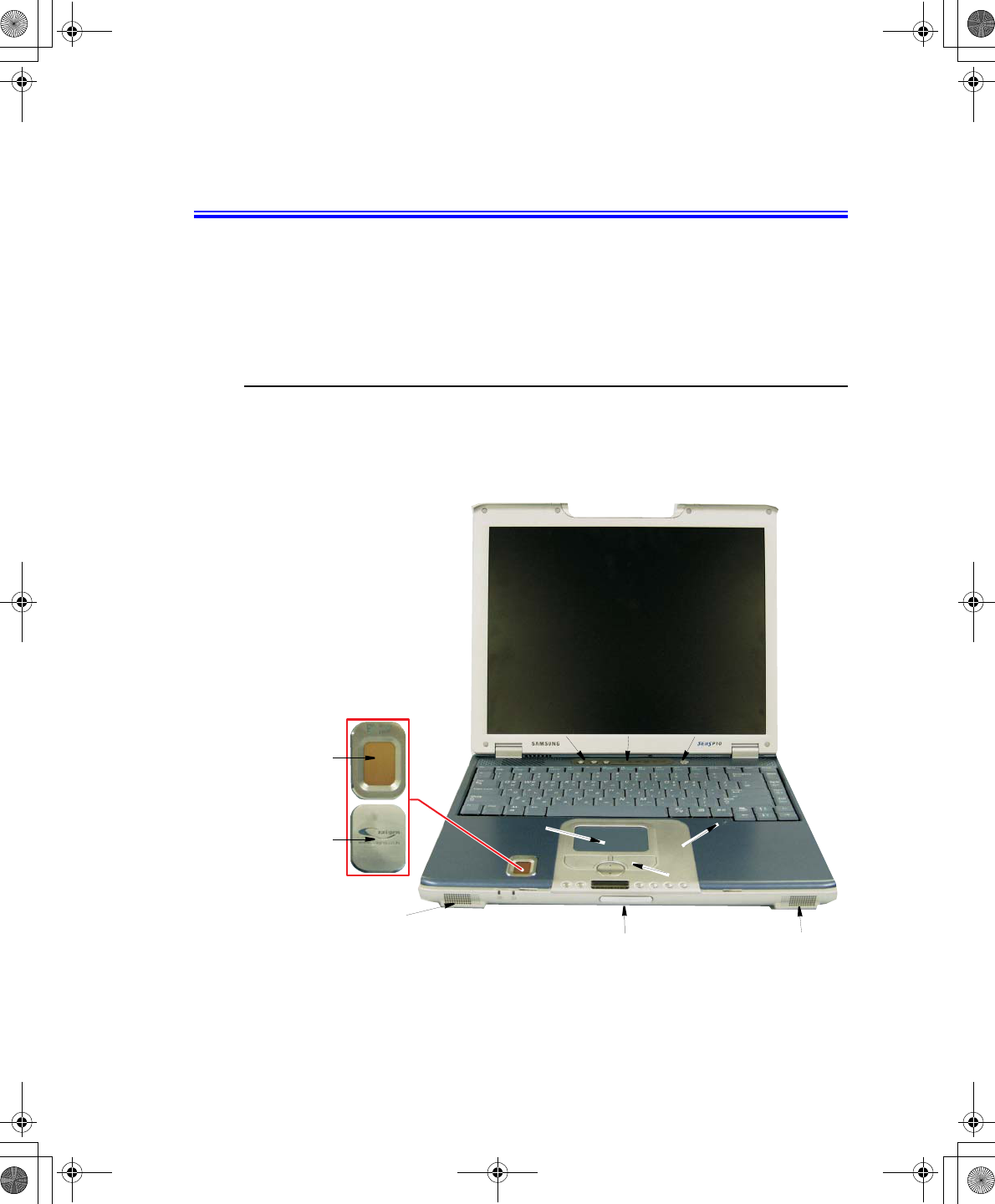
Introducing Your Computer 3
Introducing Your Computer
Your computer is a lightweight portable computer that includes features such as Dolby
Digital & Dolby Home Theater System support, CD-ROM/floppy drives, Biometric
(fingerprint) security system/Memory Stick (factory options) and wireless LAN
capability (factory option), to meet your computing needs at home or on the road.
[Figures may be different depending on options).
Where Everything Is
The next 7 figures will explain the location of all of the buttons, LEDs and equipment
needed to operate your notebook computer.
Front
This figure shows the Biometric Security option installed.
SENS Keyboard
Buttons
Touchpad
Speaker
Touchpad Buttons
Power Button
LCD Latch
LEDs
Keyboard
Speaker
Biometric
Security
pad
Internal Microphone
NOTE:
The Biometric Security
Pad will be replaced by the
protective cover if the
option is not ordered.
Protective
Cover
Taurus (Windows XP) - English.fm Page 3 Thursday, March 28, 2002 6:06 PM
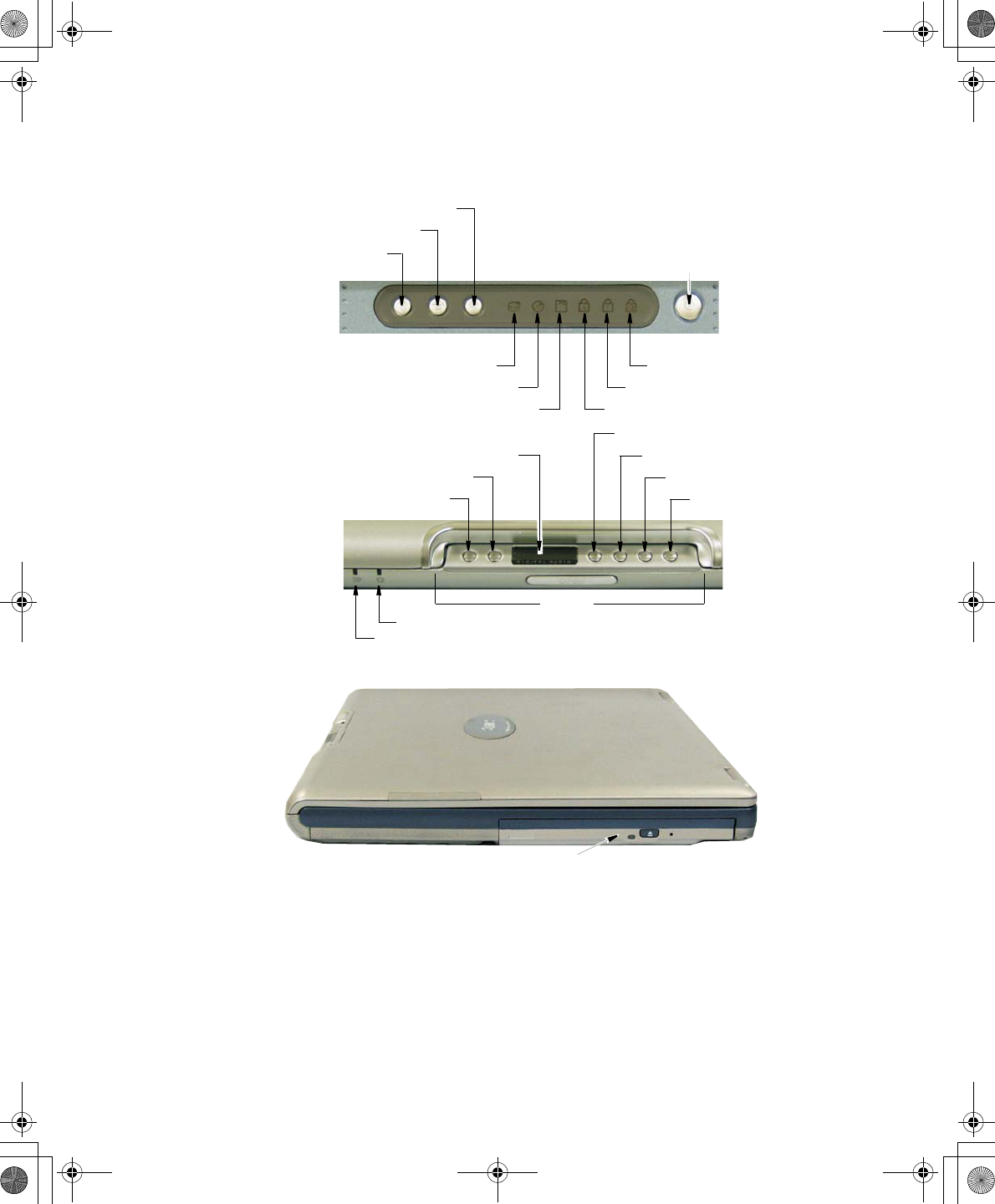
4 Users Manual
Buttons and LEDs
Right Side
HDD Access Icon Scroll Lock Icon
Power Button
Internet Button
E-Mail Button
User Programmable Button
Number Lock Icon
Caps Lock Icon
FDD Access Icon
CD Access Icon
Next/Fast Search-Forward
Stop/Eject-Power Off
Previous/Fast Search-Reverse
Power On-Play/Pause
Audio DJ
Power LED
Power, Play/Pause
& Track Indicator
Battery Status LED
Volume Down
Volume Up
CD/DVD - ROM
Taurus (Windows XP) - English.fm Page 4 Thursday, March 28, 2002 6:06 PM
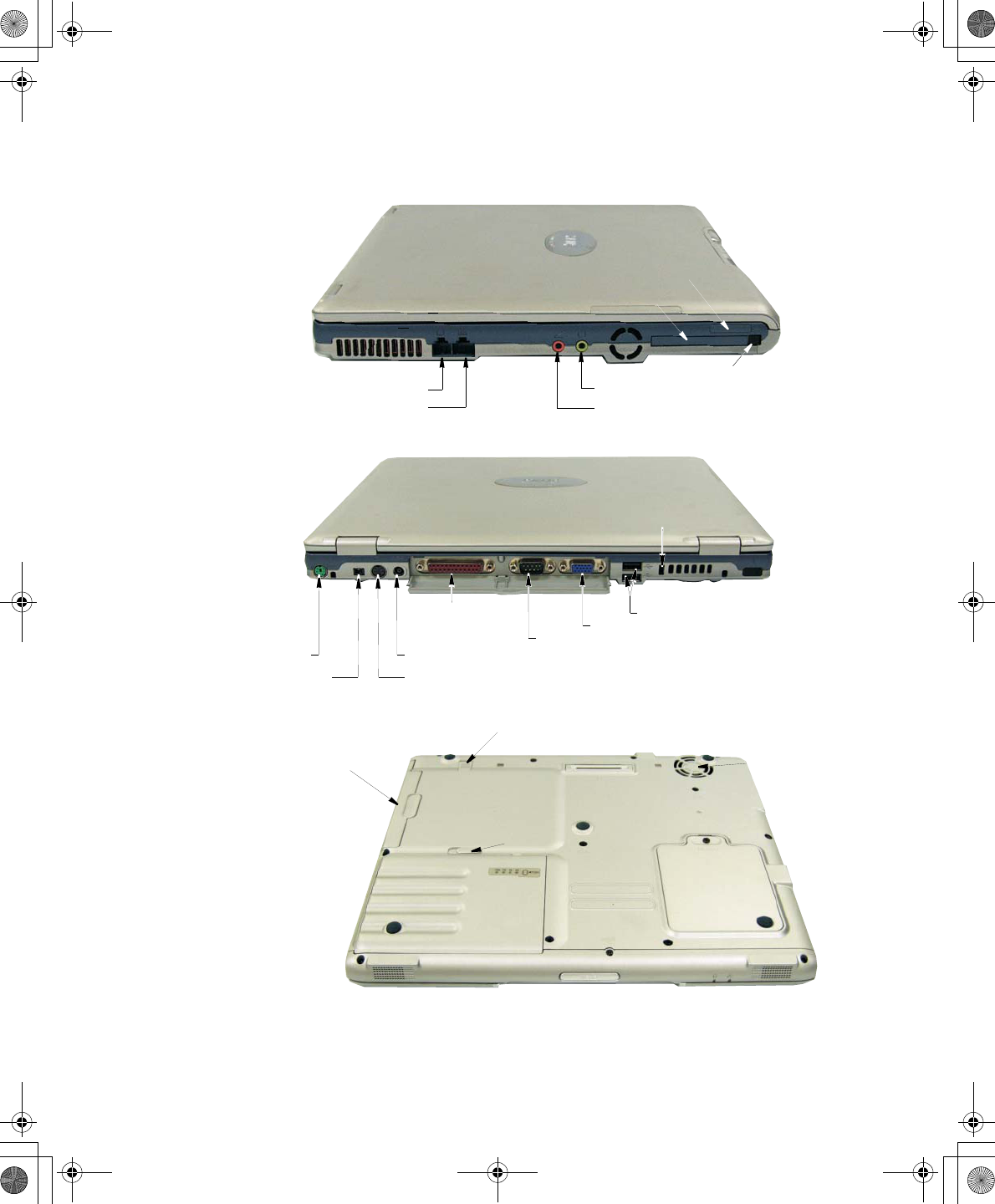
Introducing Your Computer 5
Left Side
Back Side
Bottom
PC Card Eject Button
PC Card Slot
Fan Vent
Microphone Jack
Headphone / S/PDIF Jack
Memory Stick Slot
* Factory Option
Fan Vent
Modem Port
LAN Port
External Monitor Port
Parallel
Printer Port
PS/2 Port
USB Ports
1394 Port
DC-In Port
Fan Vent
VHS TV-Out Port
Security Lock Port
FIR
* Factory Option
Serial Port
Fan Vent
Battery
Flex-Bay
Compartment
Flex-Bay Latch
Compartment
Memory
Compartment
Docking
Battery Latch
Connector
Taurus (Windows XP) - English.fm Page 5 Thursday, March 28, 2002 6:06 PM
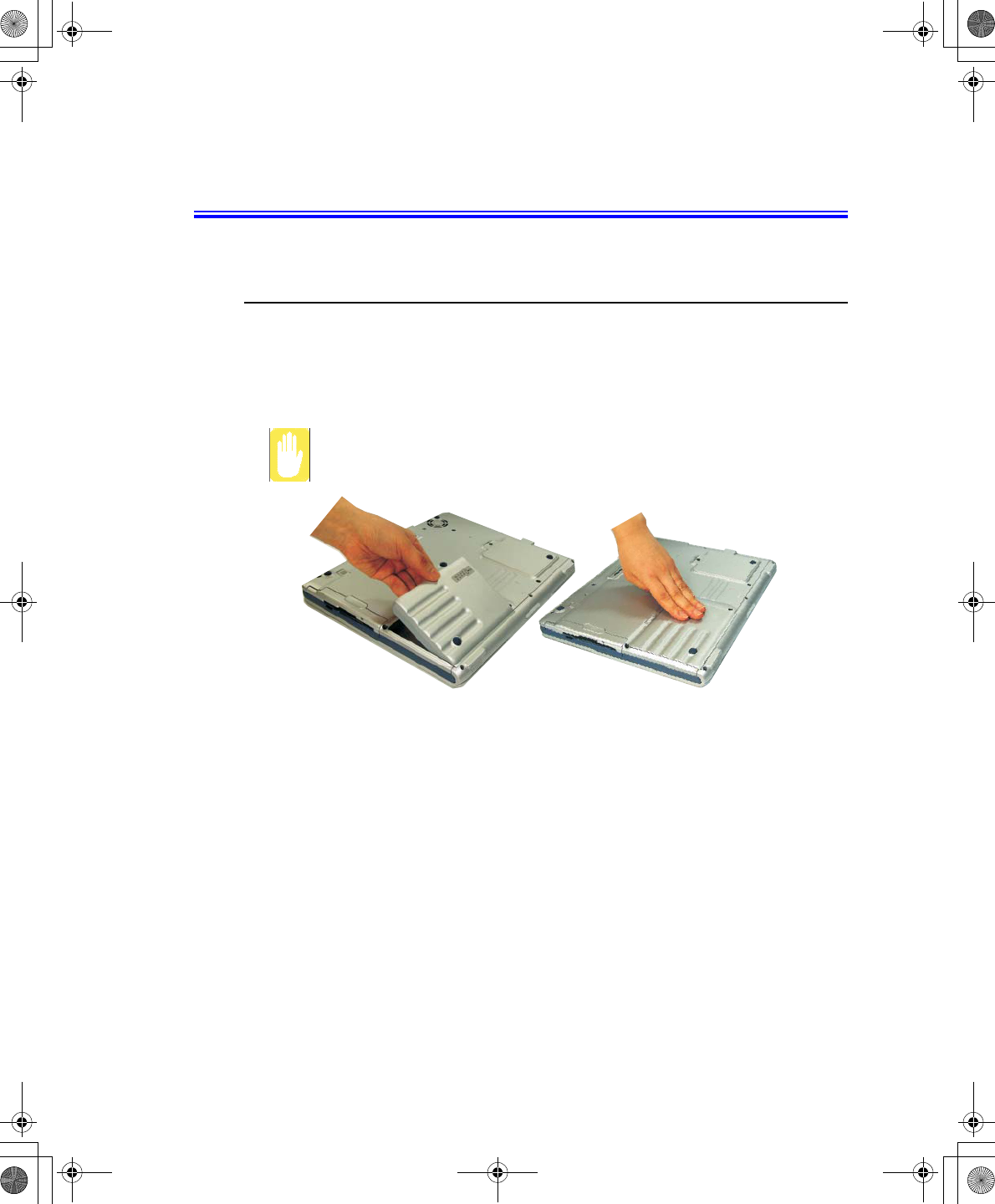
6 Users Manual
Using Your Computer for the First Time
This section gives you detailed information on using your computer for the first time.
Installing the Battery
To install the battery pack:
1. With the computer’s power off, close the LCD panel and turn the computer over
so the bottom of the unit faces up.
Insert the battery into the battery compartment, ensuring the correct
orientation so that the battery fits in its slot properly.
2. Place the battery inside and against front side of the computer battery compartment
at an angle of approximately 30 degrees.
3. Push the battery down until the latch snaps into place, securing the battery.
Taurus (Windows XP) - English.fm Page 6 Thursday, March 28, 2002 6:06 PM
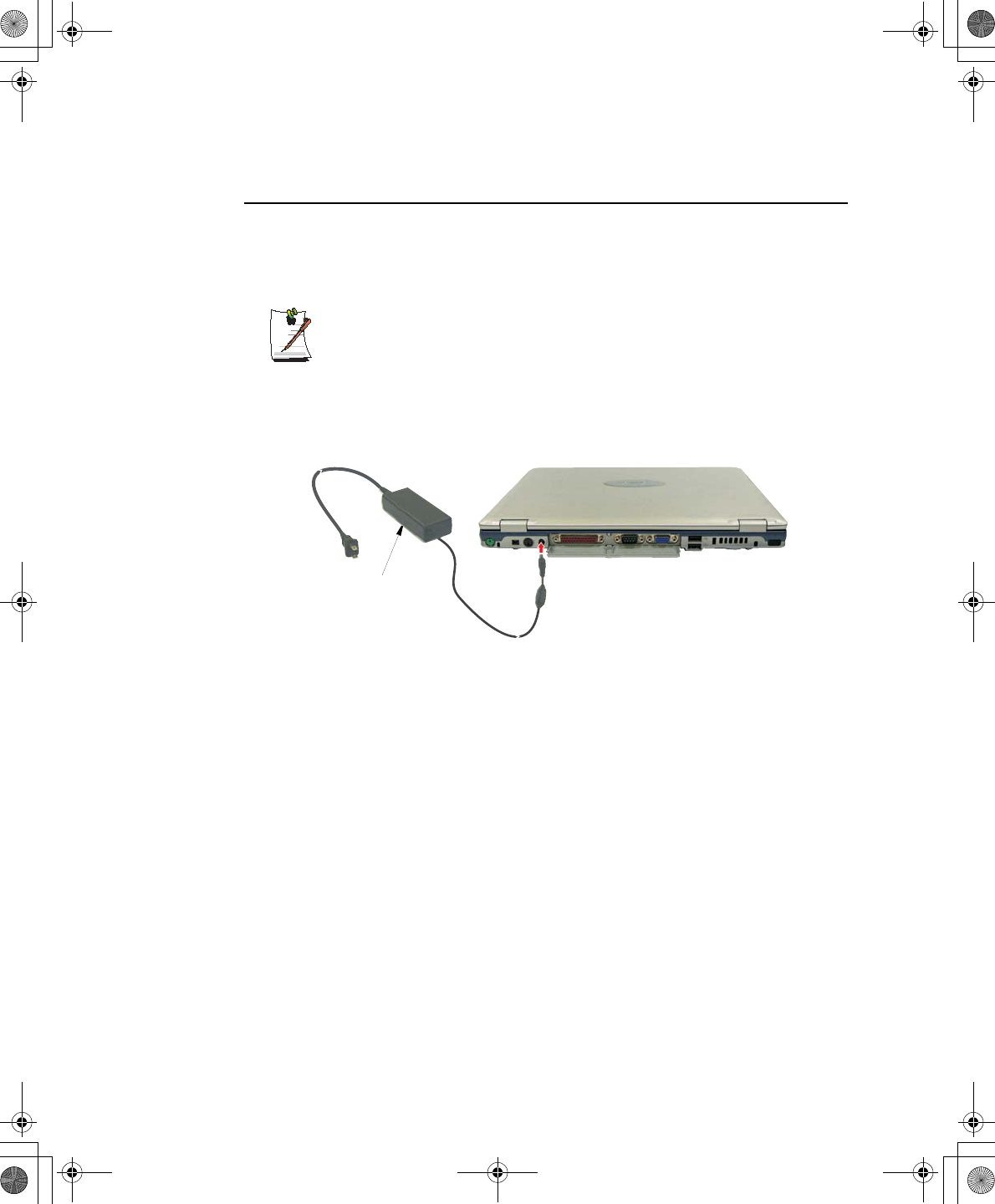
Using Your Computer for the First Time 7
Attaching the AC Adapter
Your computer runs on power from the battery in the computer or from an electrical
outlet. The first time that you use your computer, fully charge the battery by attaching
the power cord to the computer and to an electrical outlet.
All batteries lose their charge if they sit unused for an extended time period.
When not used, battery can discharge fully in 2 to 3 months. The battery may
have discharged in the time it took for the computer to go from the factory to
you.
To attach the power cord:
1. Plug the AC adapter into the power connector on the back side of the computer.
2. Connect the power cord to the AC adapter and then to an electrical outlet.
The battery starts charging as soon as you plug the power cord into an electrical outlet.
The battery charges faster if the computer is turned off during charging.
If the battery is fully depleted and the computer is turned off, the battery charges in
about 3 hours. If the computer is turned on, the battery charges in about 6 hours. When
the battery is charging, the battery charge light is red. When the battery is fully charged,
the light turns green.
See ”Using Power Management Options” on page 53 for more information on using
your computer’s battery.
AC Adapter
Taurus (Windows XP) - English.fm Page 7 Thursday, March 28, 2002 6:06 PM
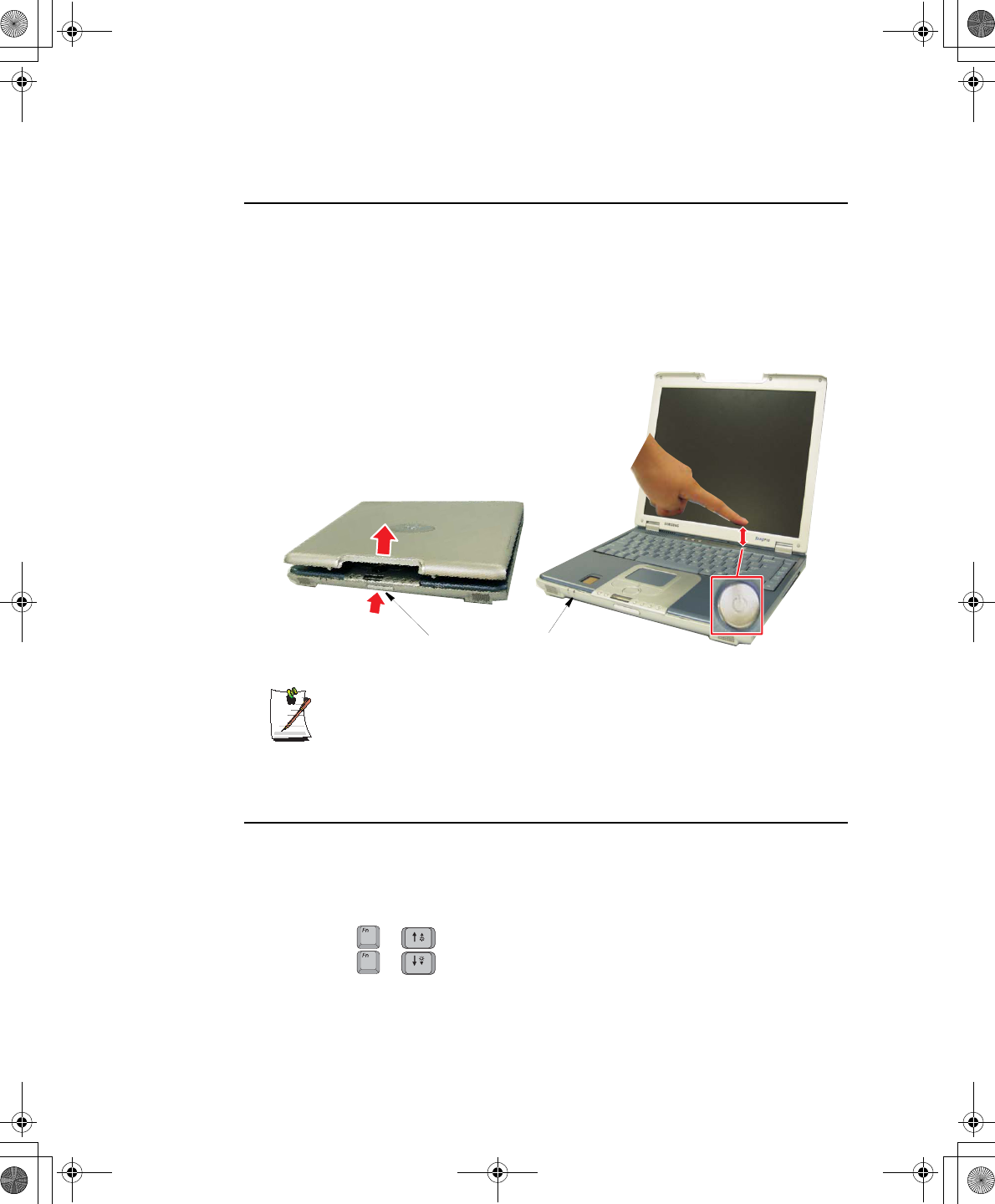
8 Users Manual
Turning On the Computer
To turn on the computer’s power for the first time:
1. Push the LCD cover button, located on the front of the computer below the Audio
DJ.
2. Lift up the cover.
3. Press and then release the power button.
The power light is on when the computer’s power is on.
Initial Computer Startup:
The first time you start your computer you will see the operating system
registration screens. Simply read each screen and follow the simple directions.
You must complete this process in order to use your computer. A tutorial is
provided if you require it.
Adjusting the LCD Display
You may wish to adjust the LCD (Liquid-Crystal Display) when you begin using your
computer. A TFT (Thin-Film Transistor) LCD does not require adjustment for contrast
because the contrast is set to remain at maximum.
To adjust the LCD:
•Press <Fn+Up Arrow> to increase the display brightness.
•Press <Fn+Down Arrow> to decrease the display brightness.
Power Button
Cover Latch Button Power Light
+
+
Taurus (Windows XP) - English.fm Page 8 Thursday, March 28, 2002 6:06 PM
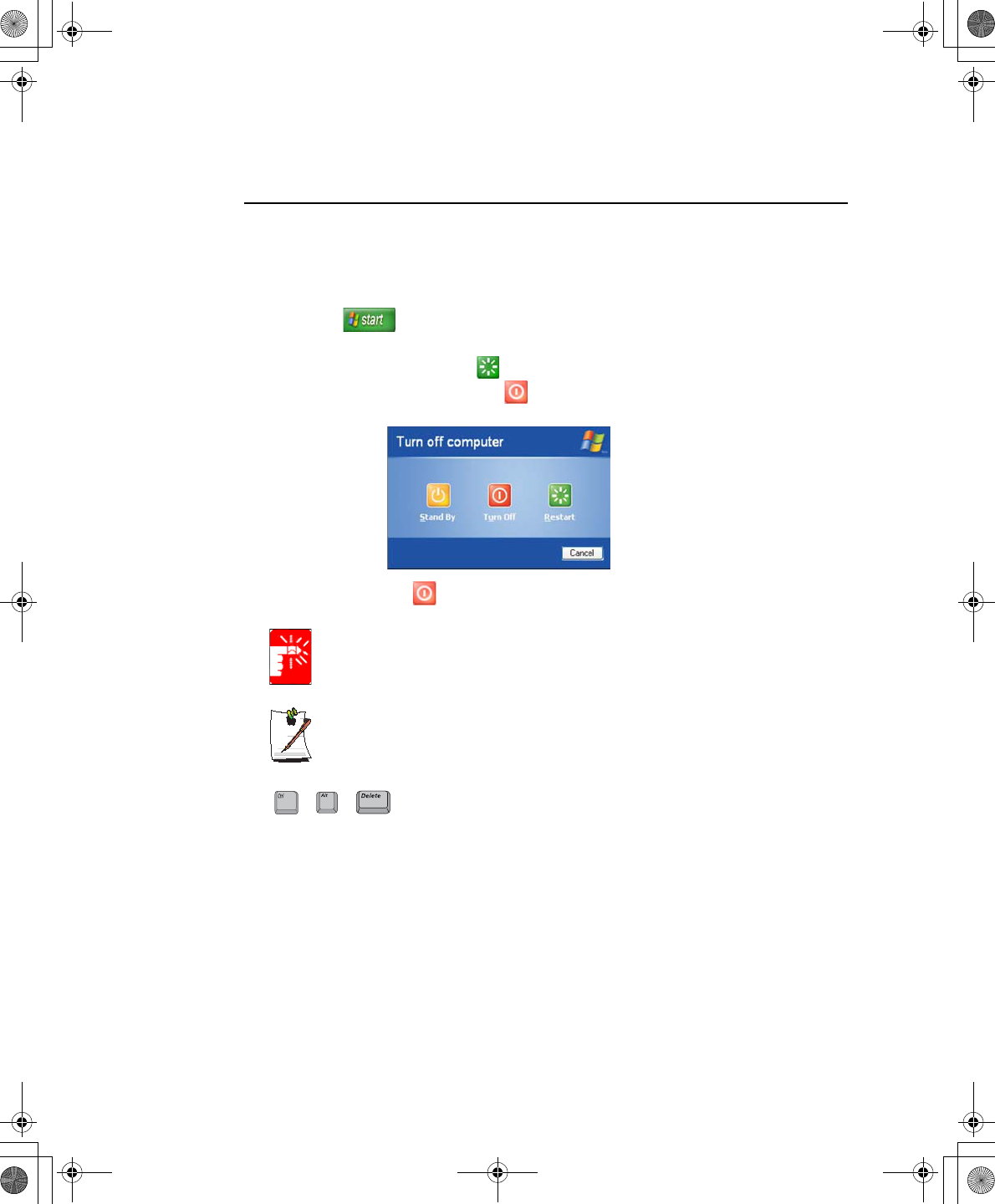
Using Your Computer for the First Time 9
Turning Off Your Computer
Prior to shutting down your computer ensure all of your data and current work are
saved. The system will ask if you wish to save any unsaved work, saving your work
first will speed the shutdown process.
To turn off the computer, complete the following steps:
1. Click on the taskbar.
If you need to restart your computer after software (re)installation or because it is not
responding select the Restart option in step 3 below.
2. Click Shut Down Computer to display the shutdown popup window shown
below.
3. Click Turn Off to complete the shutdown sequence.
Power Off:
If the system does not power off, then press and hold the power button for over
5 seconds. See ”Using Power Management Options” on page 53.
Power Button Functions:
The power button has several functions other than just turning on and off your
computer, see “Using Power Management Options” on page 53.
You can also perform a soft boot by saving your files and pressing
<Ctrl+Alt+Del> to pop-up the “Windows Task Manager” window.
Click Shut Down > Restart.
You can perform a cold boot by pressing the power button for more than 4 seconds to
turn the computer off, waiting more than five seconds, and then pressing the power
button to turn the computer on. The system may perform some extra checks during the
restart.
+ +
Taurus (Windows XP) - English.fm Page 9 Thursday, March 28, 2002 6:06 PM
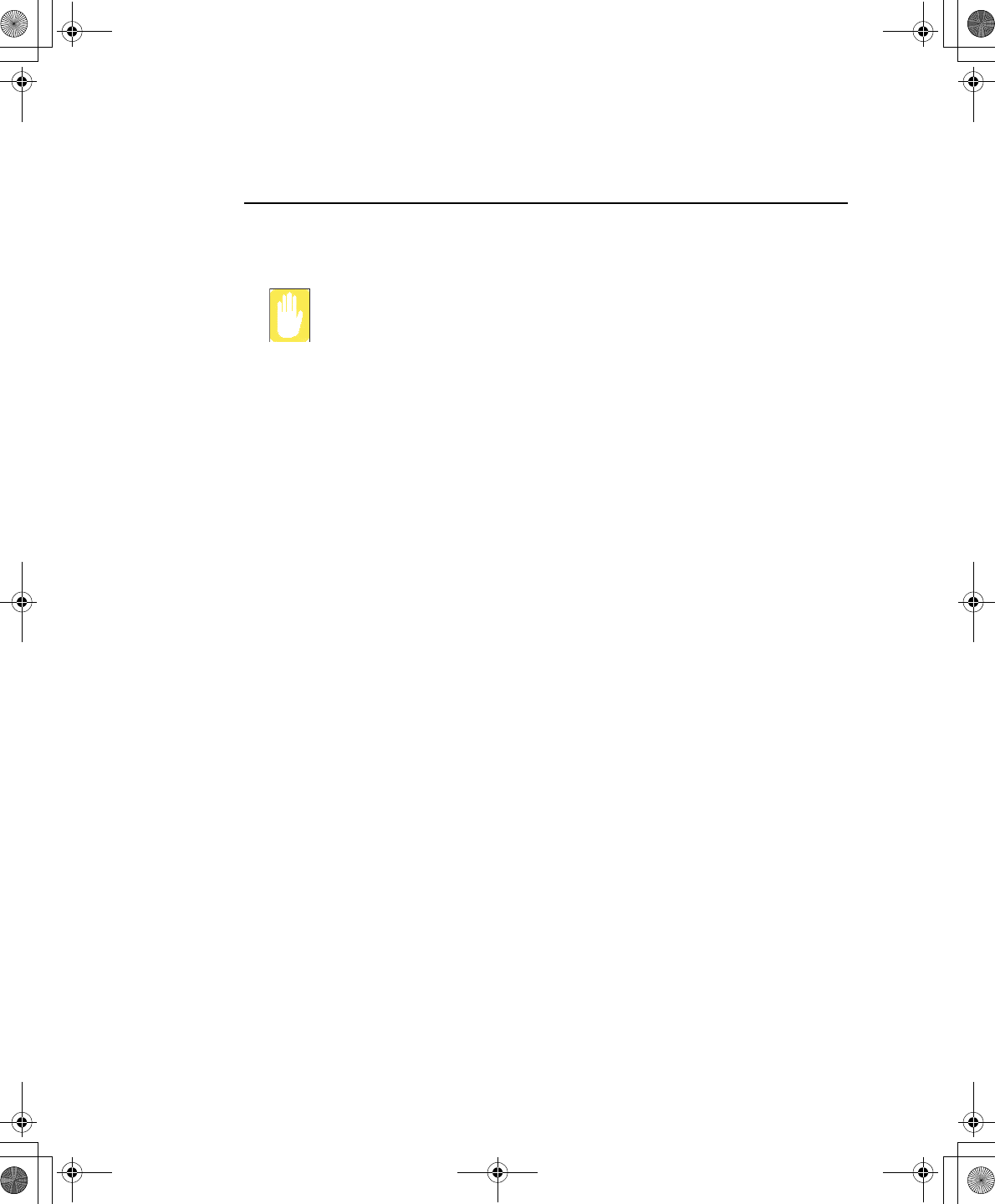
10 Users Manual
Tips for Using Your Computer
The following information helps you avoid potential problems as you use your
computer:
Do not try to disassemble your computer. Opening the system chassis voids
your warranty. Only an authorised manufacturer service center can replace or
add any parts inside the chassis.
•Follow all the instructions and cautions in your computer user documentation.
•The LCD has a polarized surface and can be damaged easily. To prevent
damage, avoid touching the screen.
•Use only approved AC adapters, auto adapters, memory modules and other
options.
•Because a notebook computer is small and has restricted air flow around
components, it is more likely to overheat than a desktop computer. A fan inside
your computer runs when needed to help eliminate heat. Make sure the fan vent
on the left side of your computer is not blocked when you use the computer.
Occasionally check the vents and remove any accumulated dust on the outside.
•Avoid using or storing the computer in extremely hot or cold areas, such as a
car on a hot day. Keep the computer away from heaters and out of direct
sunlight. Exposure to excessive heat may damage computer components. If you
have left your computer in a hot place, let it cool down slowly to room
temperature (with the LCD panel open) before using it.
•Do not remove the memory-module compartment door, or try to install a
memory module when the computer is on. (For information on installing
memory modules, see “Installing a Memory Module” on page 65.)
•Set up your computer work area to avoid physical strain. Sit with your back
straight and supported by your chair. Adjust your chair or work table so that
your arms and wrists can remain in a relaxed position, parallel with the floor.
Avoid bending or twisting your wrists as you work. Your hands should “float”
slightly above the keyboard. Refer to a book on office ergonomics for more
information on setting up your work area.
•Take frequent breaks from working at the computer to rest your eyes and
stretch your muscles.
•Remember to save your data files frequently and to make backup copies of your
files.
Taurus (Windows XP) - English.fm Page 10 Thursday, March 28, 2002 6:06 PM
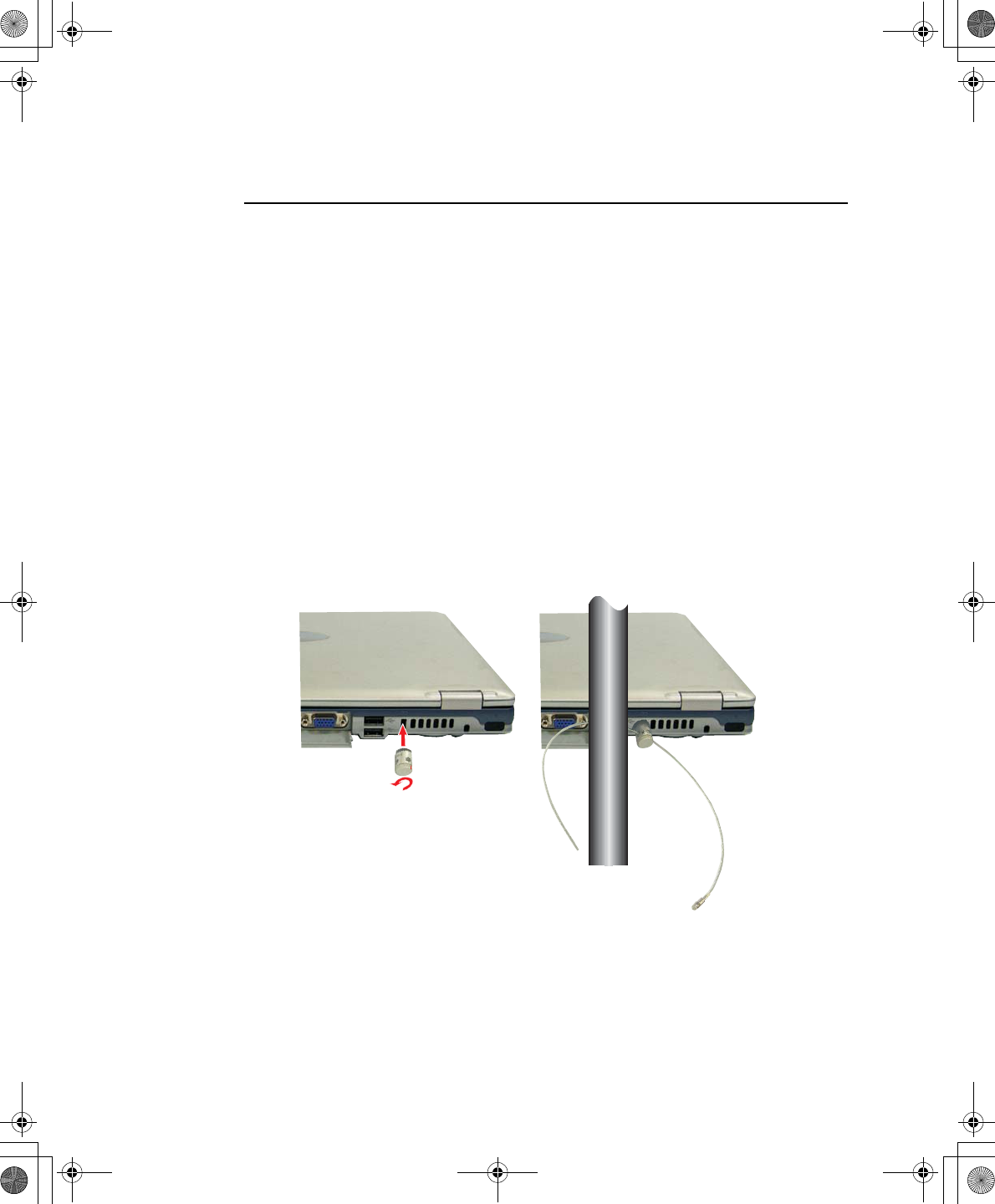
Using Your Computer for the First Time 11
Travelling with Your Computer
Air Travel
If you are travelling by air, follow these tips:
•Take the computer with you as carry-on luggage. Do not check the computer
with your baggage.
•Allow the computer and disks to go through the X-ray security devices. Do not
hand-carry disks through the walk-through metal detectors, which can cause
loss of data.
•Make sure that the battery is charged or the power cord is easily accessible.
You may be required to turn on the computer for airport security personnel.
•Be prepared to turn off the computer during take off and landing.
Locking your Computer
As a precaution when you are travelling or using your computer in an unsecured area,
you should keep your computer as safe as possible. An option to do this is the Security
Lock System. Follow the Security Lock System manufacturers instructions for specific
installation and use.The following figure shows generally how to use the lock.
To Lock
From Lock
Taurus (Windows XP) - English.fm Page 11 Thursday, March 28, 2002 6:06 PM
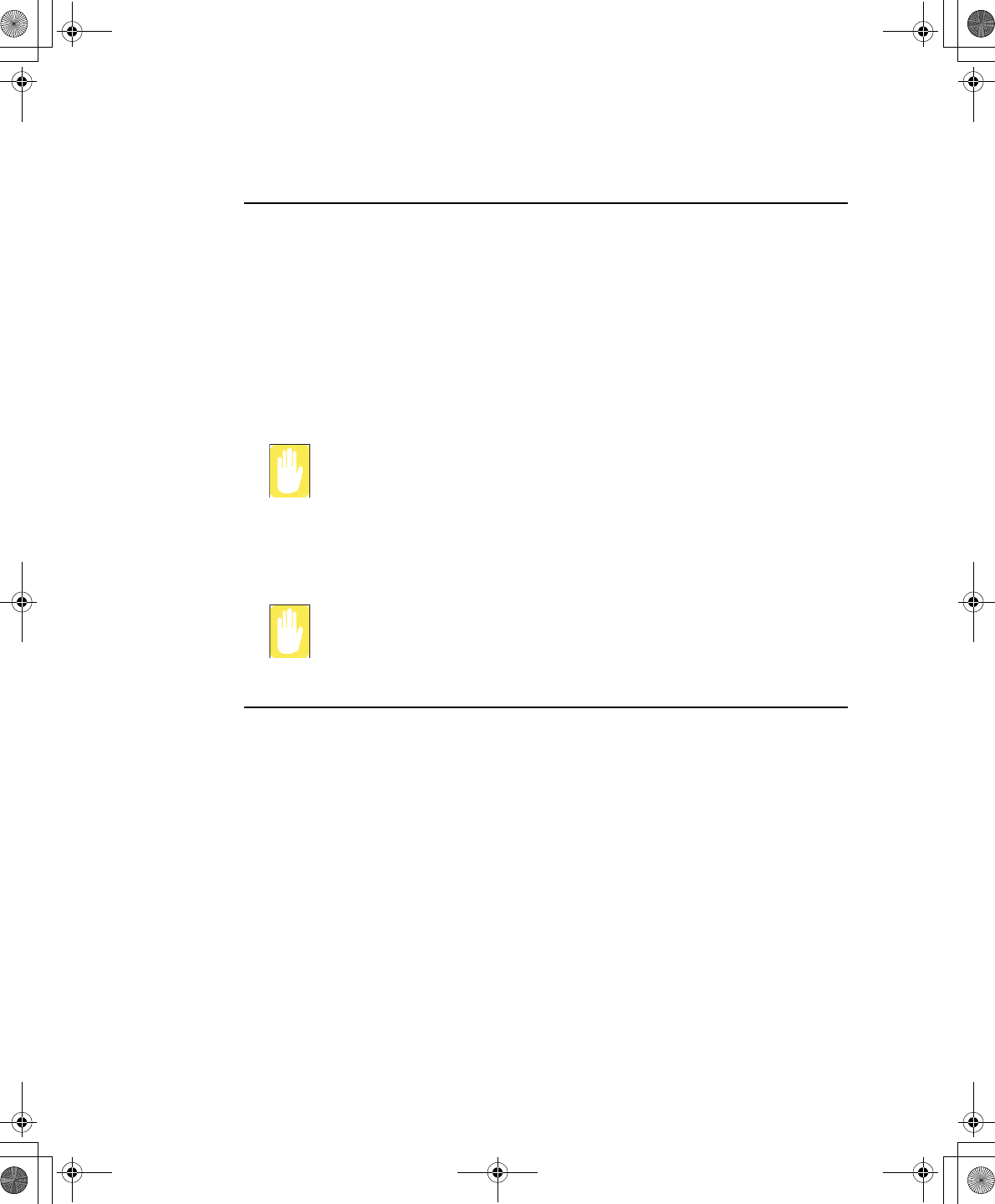
12 Users Manual
Handling Spills
Do not spill anything on your computer. The best way to avoid spills is to avoid eating
and drinking around your computer. If you do spill something on your computer, turn
off your computer, unplug it immediately, and do the following:
•If you spill liquid on the keyboard, drain as much of the liquid from the
keyboard as possible. Be careful not to let the liquid drip onto the LCD panel.
Allow the system to dry for several days before trying to use it.
•If you spill liquid on an external keyboard or keypad, unplug it and drain as
much of the liquid as possible. Allow the keyboard to sit at room temperature
for a full day before trying to use it.
Sweet liquids leave a sticky residue that may jam the keyboard despite your
efforts to dry it.
•If you spill liquid on the LCD panel, clean it immediately with a soft cloth and
denatured alcohol or a proprietary LCD screen cleaner. Do not use water,
window cleaner, acetone, aromatic solvent, or dry, rough towels to clean it.
Some liquids damage the polarized LCD screen. If your screen is damaged,
contact your authorized manufacturer’s service center for a replacement.
Storing the Computer for Long Periods
If possible, leave the power cord connected to the computer and an electrical outlet
when the computer is not in use. This extends the life of the battery and keeps the
battery fully charged.
If you will not be using the computer for a long period of time (a month or more), you
should charge the battery until it is completely full. After you have done so, remove the
battery from the unit.
Taurus (Windows XP) - English.fm Page 12 Thursday, March 28, 2002 6:06 PM
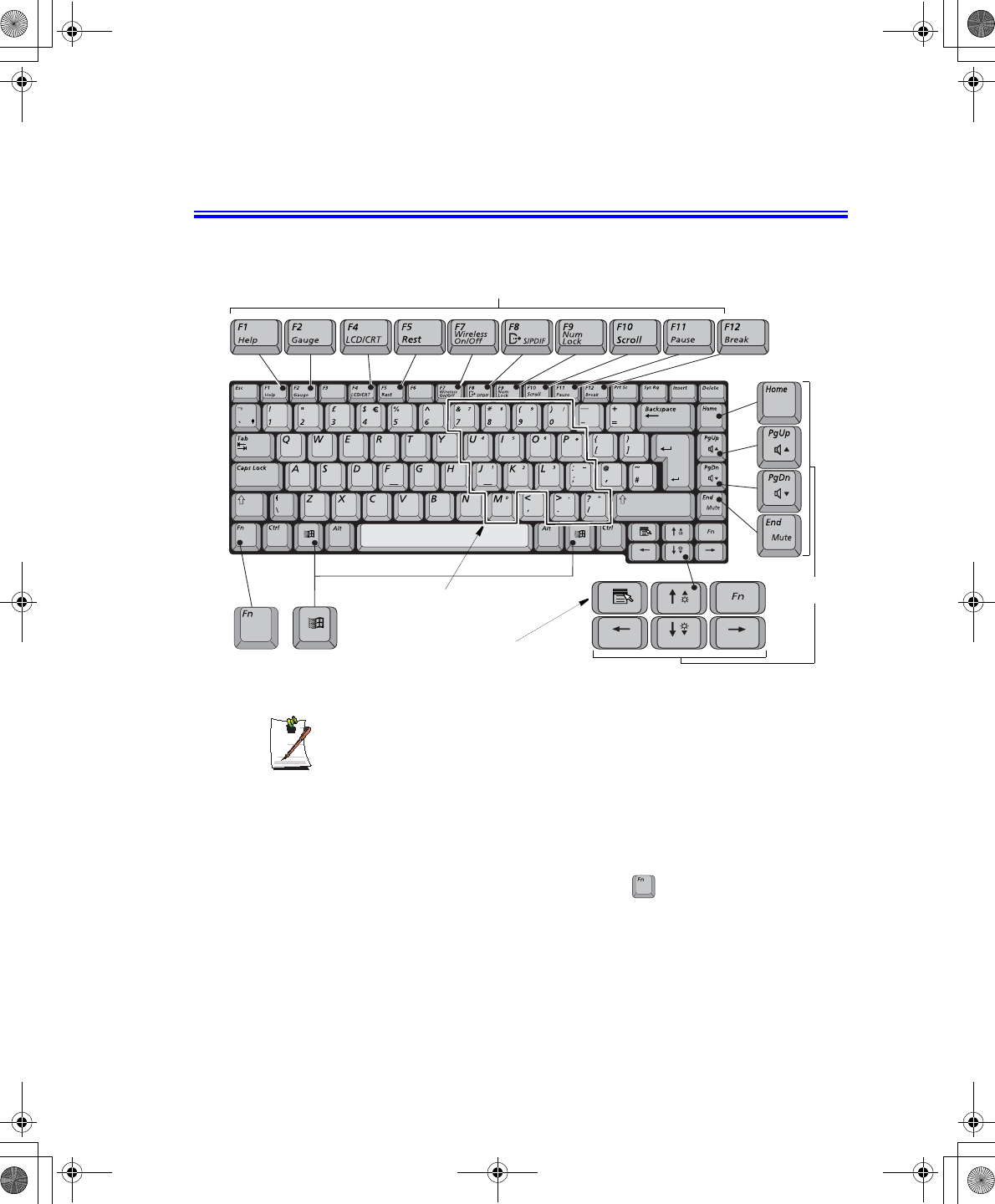
Using the Keyboard 13
Using the Keyboard
Your computer has an 87/88-key keyboard. By pressing designated key combinations,
you can have access to all the key functions of a full-sized keyboard.
Although the layout of the keys on your computer’s keyboard is different from
that on a desktop computer’s keyboard, the keyboard feels like a full-sized
keyboard when you use it.
The keys on the keyboard can be grouped into the following categories:
•Full-sized Alphanumeric typewriter keys are arranged like a standard
typewriter keyboard and are used for text entry. The Windows keys on either
side of the spacebar open Windows menus and perform other special functions.
•Function keys, when pressed together with the key, enable special
functions.
•Cursor and Screen control keys move the cursor. They may perform other
functions, depending on your software.
Function & Special Purpose Keys
Embedded Numeric Keypad
Application Key
Cursor/Screen
Control Keys
Windows
Key
Function
Key
Taurus (Windows XP) - English.fm Page 13 Thursday, March 28, 2002 6:06 PM
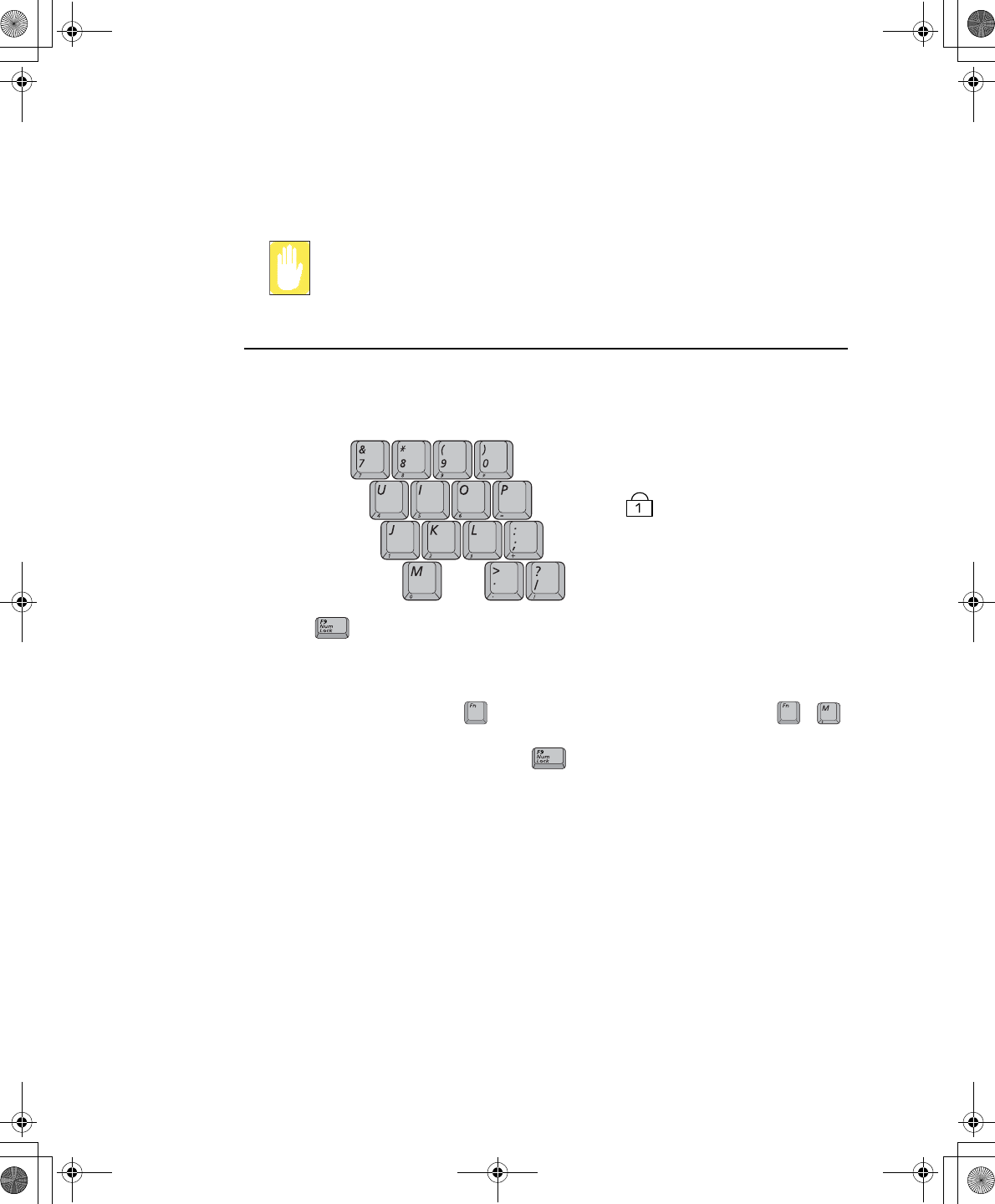
14 Users Manual
To clean the computer keyboard, use slightly damp cotton swabs. Scrub the keys and
the surface around the keys.
Do not allow liquid to drip into the keyboard or you may damage the keyboard.
Using the Numeric Keypad
Your keyboard includes a numeric keypad, which is a group of keys that you can set to
type numbers and mathematical symbols, such as the plus sign. A number or symbol
on the right corner of each keypad key shows its numeric function.
Press to turn on the embedded numeric keypad. The numeric functions of the
keypad are enabled and the Num Lock LED turns on. (See ”Reading the System Status
Lights” on page 20 for the location of the Num Lock LED.)
While the numeric functions are enabled, you can temporarily return a key to its normal
function by pressing and the key. For example to type the letter m, press + ,
this operation displays the letter m.
To turn the numeric keypad off, press again. The Num Lock LED turns off.
Num Lock LED
Taurus (Windows XP) - English.fm Page 14 Thursday, March 28, 2002 6:06 PM
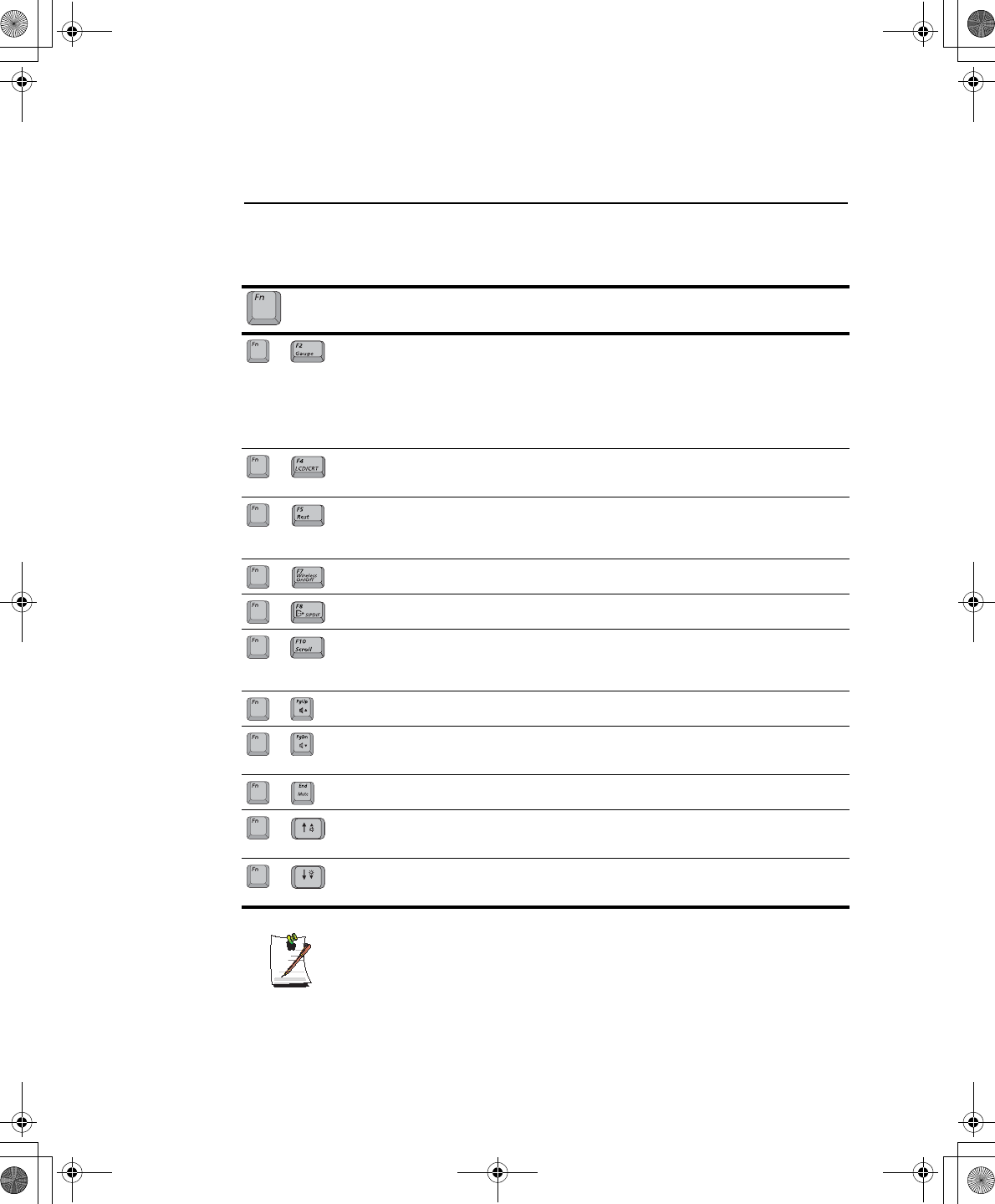
Using the Keyboard 15
Using Special Function Keys
The function key activates special functions when it is pressed in combination with
another keys. Table 2 shows the special key combinations.
Table 2. Description of Special Function Key Combinations
When you press a function key combination, the system sound may be
temporarily muted.
Key
Combinations Key Name Key Function
F2
Gauge
Gauge Displays the battery gauge in the upper-right corner of
your screen.
The gauge closes in a few seconds, or you can press
<Esc> to close the gauge. (See ”Monitoring the Battery
Charge” on page 43 for more information on the battery
gauge.)
This function will also display status of Wireless LAN and
S/PDIF functions.
F4
CRT/LCD
CRT/LCD: Switches the display between the LCD, the external
monitor, and simultaneous display on both the LCD and
the external monitor.
F5
Rest:
Rest: Puts the computer into Suspend mode. To resume
normal operation from rest, press the power button. (See
”Using Power Management Options” on page 53 for more
information about the rest mode.)
F7
WLAN
WLAN Toggles the Wireless LAN function On/Off
F8
S/PDIF
S/PDIF:Toggles the S/PDIF function On/Off
F10
Scroll
Scroll: In some applications, sets the cursor-control keys to
scroll the page up or down while the cursor position does
not change. Pressing key combination again turns off the
scrolling function.
PgUp
Volume up:
Volume up: Increases the audio volume.
PgDn
Volume
down:
Volume
down:
Decreases the audio volume.
End
Mute:
Mute: Mutes the audio.
Up Arrow
Brightness
Up:
Brightness
Up:
Increases the LCD brightness.
Down Arrow
Brightness
Down:
Brightness
Down:
Decreases the LCD brightness.
+
+
+
+
+
+
+
+
+
+
+
Taurus (Windows XP) - English.fm Page 15 Thursday, March 28, 2002 6:06 PM
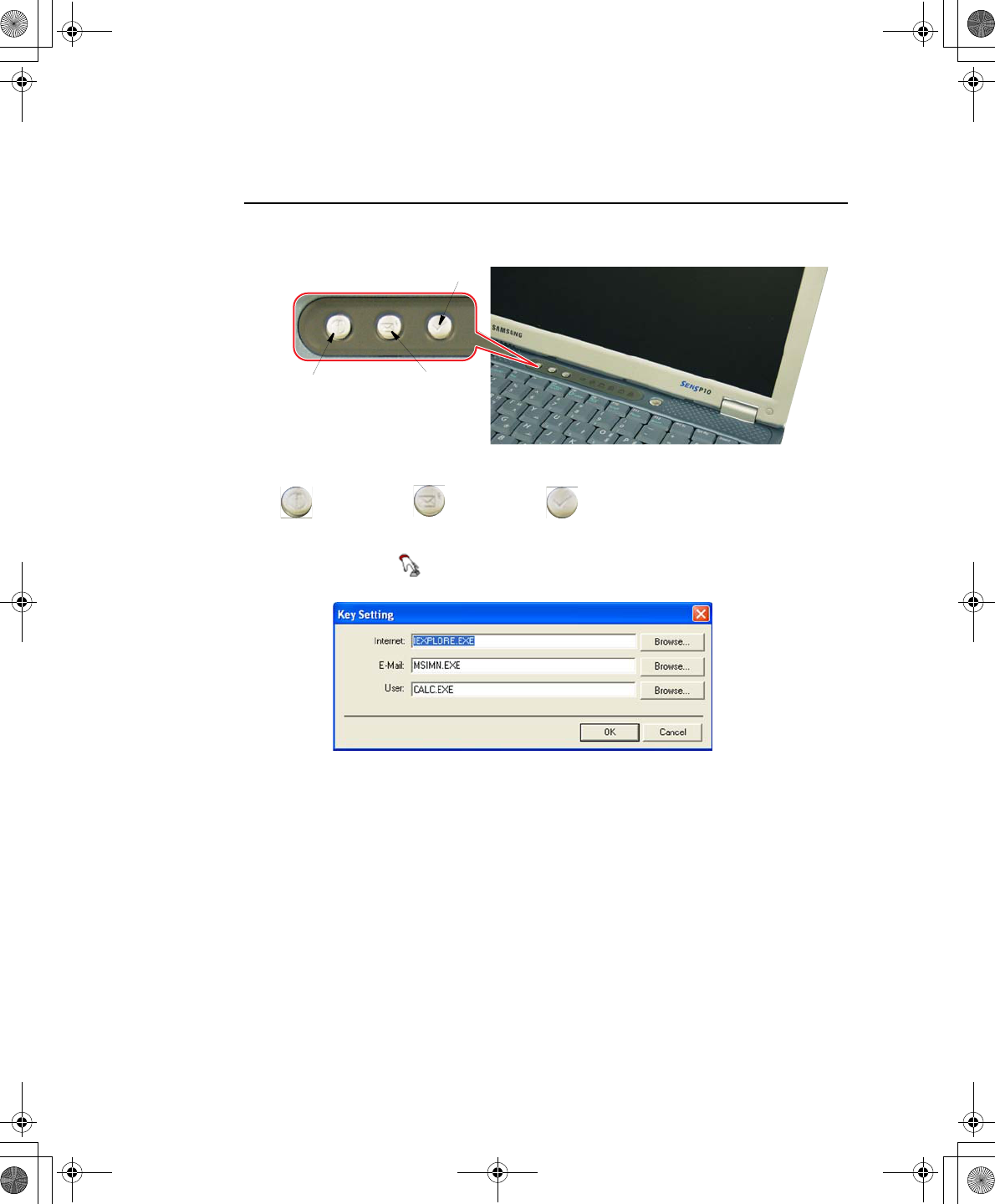
16 Users Manual
User Defined Buttons (SENS Keyboard)
You may program the three buttons to the left of the power button to start any program
you have installed on your computer.
The default settings for these buttons are:
To reprogram the Sens Keyboard, follow the steps below:
1. Double-Click icon on the Windows taskbar, the Key Setting window is
displayed.
2. Select Button you wish to reprogram from the drop down menus in the Key
Setting window.
3. Use the Browse button to locate the program you wish to assign to the SENS
Keyboard button selected.
4. Click on your program choice to select it.
5. Click Open.
6. Click OK to close window and complete programming the Sens Keyboard.
Internet E-Mail - Outlook Windows Calculator
Internet Explorer Outlook Express
User defined program
Taurus (Windows XP) - English.fm Page 16 Thursday, March 28, 2002 6:06 PM
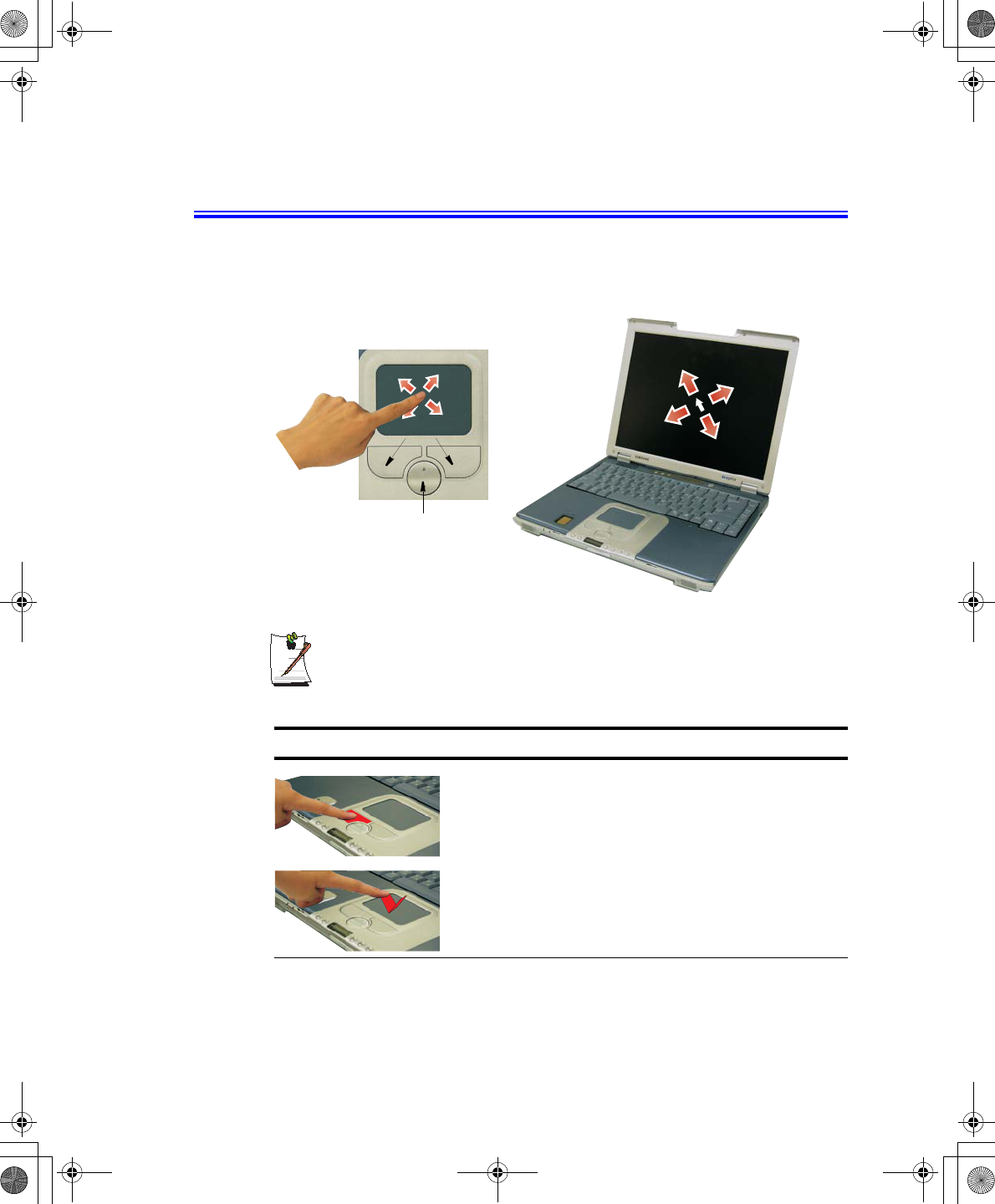
Using the Touchpad 17
Using the Touchpad
Your computer is equipped with a touchpad, which is an integrated-pointing device
that is used to perform standard mouse functions. The touchpad is an advanced and
reliable pointing device that works with a touch of your finger.
Press on the touchpad gently. The touchpad responds to light pressure.
Table 3. Using the Touchpad
Action Process and Comment
Click/Tap Process
Depress the touchpad left button and release or position the pointer
over the object and Quickly tap the touchpad once with your finger.
This action is called clicking.
Comment
This will cause a process to begin or select an object on the screen.
Touchpad
Mouse Buttons
Scroll Button
Taurus (Windows XP) - English.fm Page 17 Thursday, March 28, 2002 6:06 PM
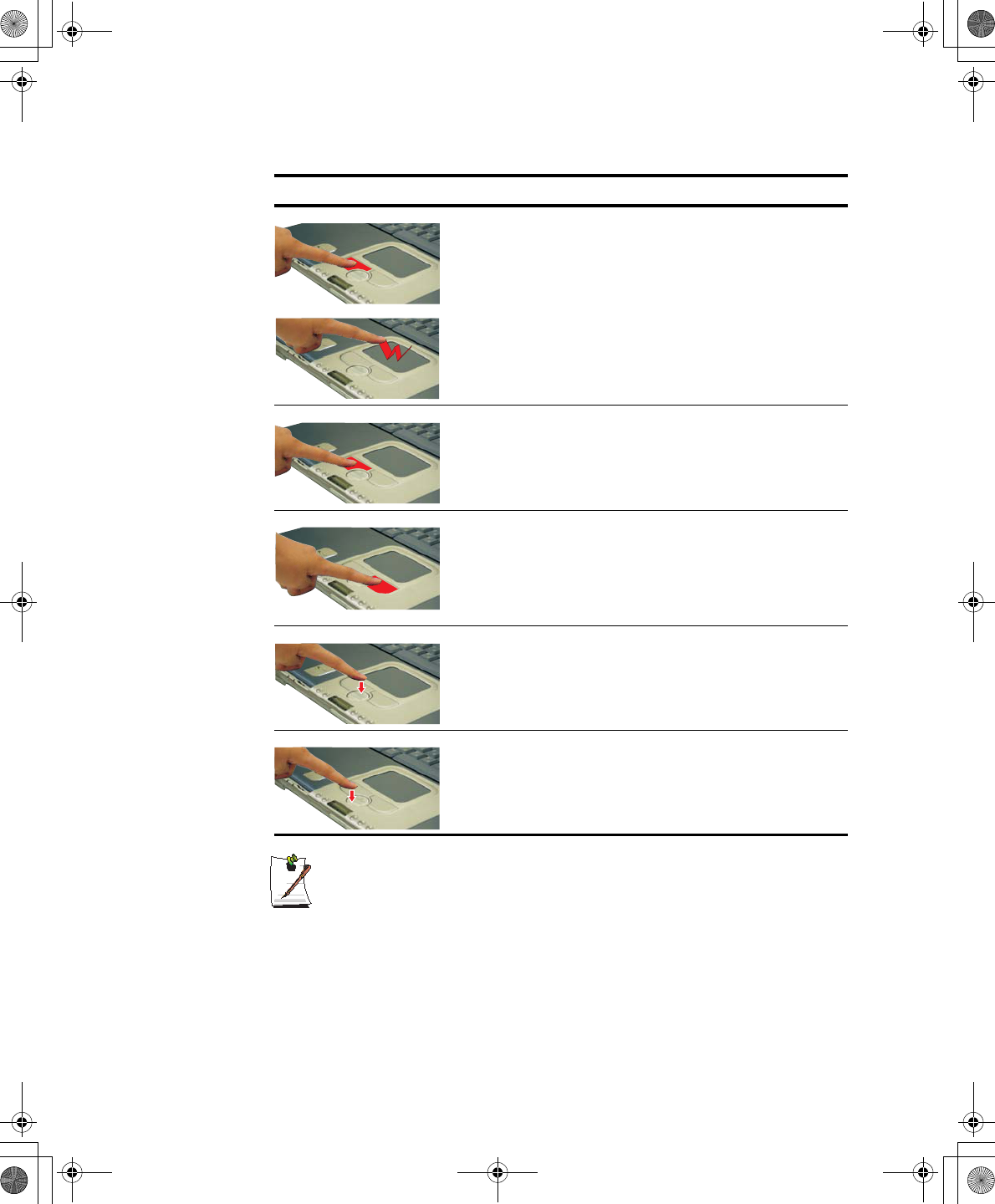
18 Users Manual
PS/2 Mouse Menu:
You may change the setup in Setup >Advanced Menu
Disabled : Prevents any installed PS/2 mouse from functioning, but frees
up IRQ12.
Enabled : Forces the PS/2 mouse port to be enabled regardless if there is
a mouse present.
Auto Detect :Enables the PS/2 mouse only if present.
Double-Click/Tap Process
Quickly click the left touchpad button two times or position the pointer
over the object and Quickly tap the touchpad twice with your finger.
This action is called Double-clicking.
Comment
This will cause a process to begin or open a file folder.
Click-Hold Process
Depress the left touchpad button and do not release.
Comment
This is used to move/drag objects to new locations. See ”Drag (Move)”
on page 19.
Right-Click Process
Position the pointer over the object. Quickly press and release the right
button once.
This action is called Right-clicking.
Comment
This is usually used to obtain information about an object or access a
short cut menu.
Scroll Up Process
Place your finger on the top half of the button to scroll up the current
window.
Comment
Moves the current window down.
Scroll Down Process
Place your finger on the bottom half of the button to scroll up the current
window.
Comment
Moves the current window up.
Action Process and Comment
Taurus (Windows XP) - English.fm Page 18 Thursday, March 28, 2002 6:06 PM
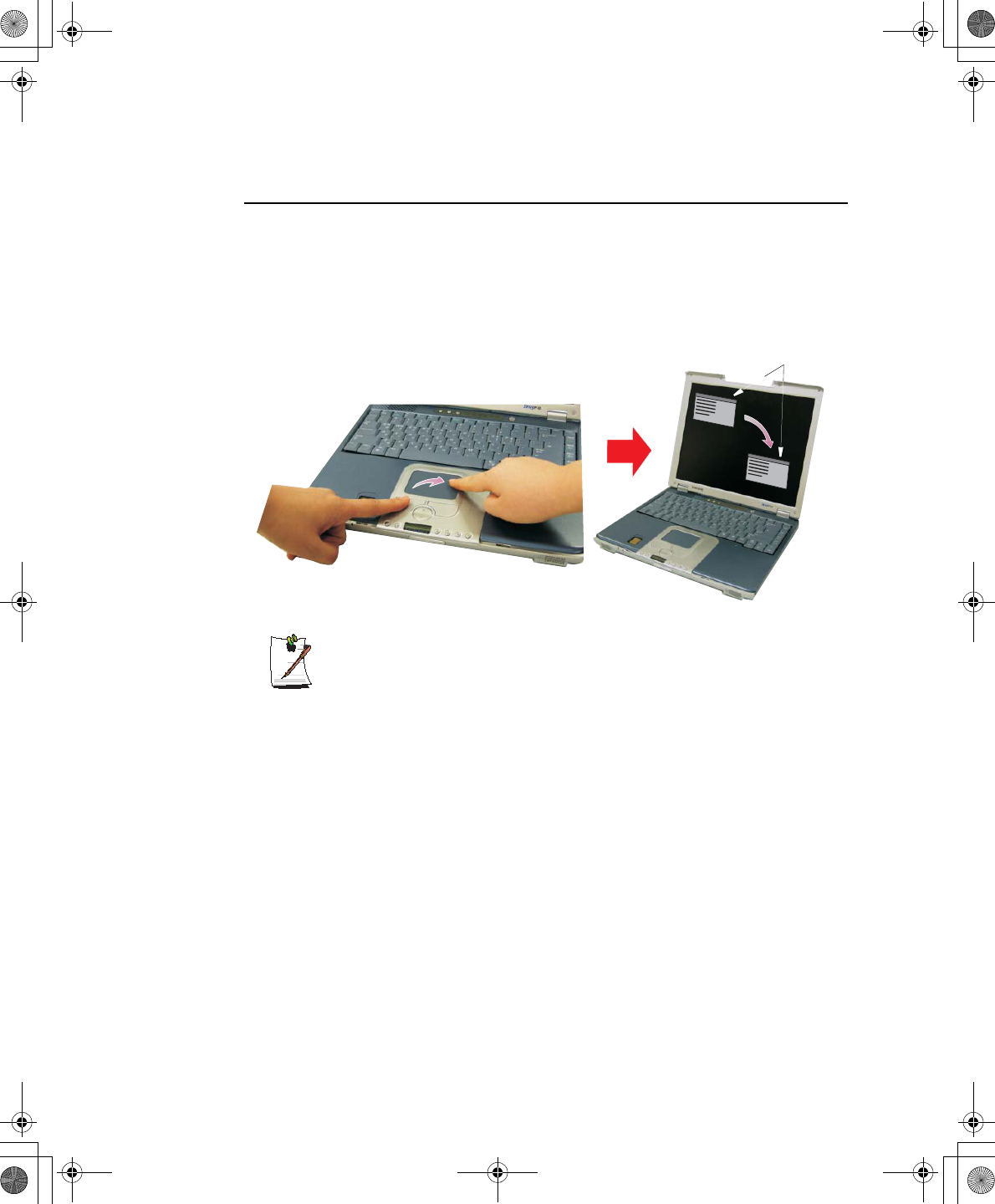
Using the Touchpad 19
Drag (Move)
To move a window on the desktop, complete the following:
1. Click the window title bar or icon in the bottom of the window which you want
to drag using the touchpad.
2. Press the left touchpad button and hold it.
3. Drag the window using the touchpad.
Area or Multiple item selection:
The drag function may be used to select an area or multiple items in an area
by clicking in one area and then dragging to create a selection window. The
items inside the window will be selected.
Cursor in Windows
Title Bar
1 Click the Window
Title Bar and Hold
1
2 Drag your finger to
move the window
2
Taurus (Windows XP) - English.fm Page 19 Thursday, March 28, 2002 6:06 PM
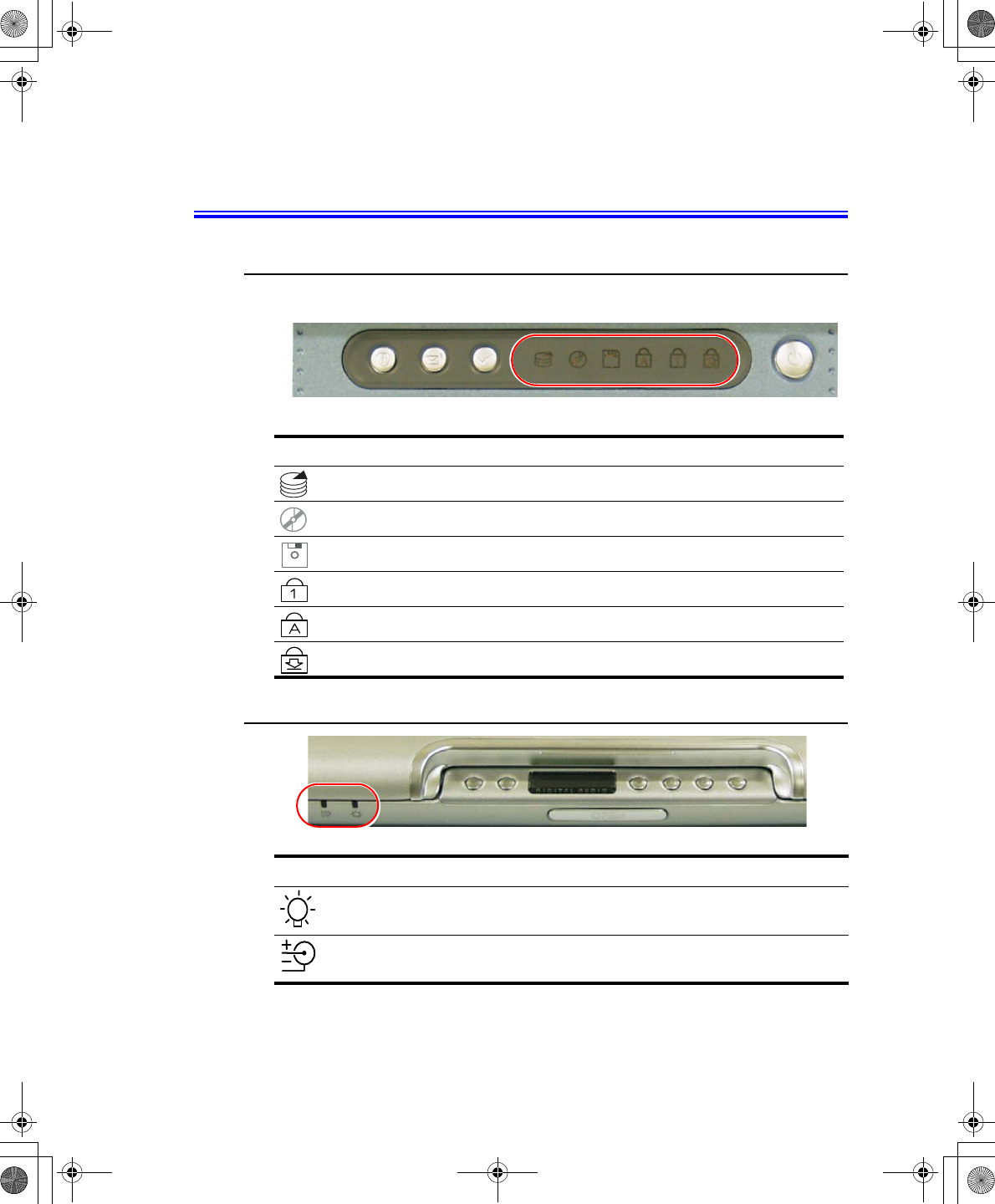
20 Users Manual
Reading the System Status Lights
System Top
System Status lights show the status of computer functions.
System Bottom
LED Name Function
HDD Access Blinking Green - HDD is being accessed.
CD Access Blinking Green - CD is being accessed.
FDD Access Blinking Green - FDD is being accessed.
Num Lock Changes a portion of the keyboard to a numeric keypad.
See ”Using the Numeric Keypad” on page 14.
Caps Lock Changes all alpha or letter input into capital letters.
No changes occur to numeric and special keys.
Scroll Lock Scroll lock in certain software.
LED Name Function
Power Green - System power on.
Blinking - Standby mode.
Battery Status Green - No battery pack installed/battery fully charged.
Amber - Charging.
Blinking - Bad Battery
Taurus (Windows XP) - English.fm Page 20 Thursday, March 28, 2002 6:06 PM
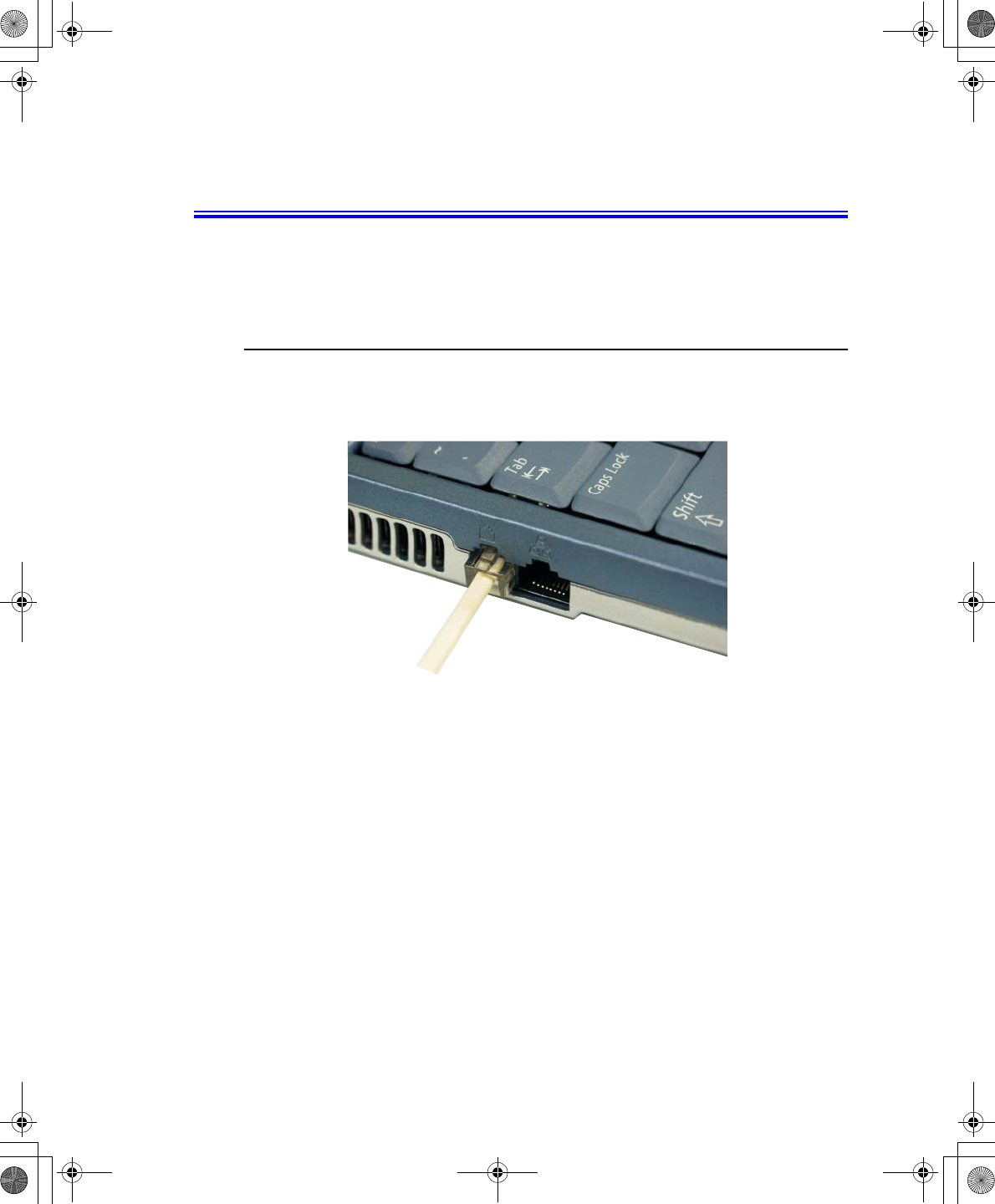
Connecting to the Internet 21
Connecting to the Internet
This section explains how to connect you to the internet. For details on how to establish
the connection contact the Internet Service Provider [ISP] or system administrator
[SysAdmin].
Using the Modem
Install the Modem cable by simply plugging the cable into the modem slot as shown in
the figure below.
Your Notebook computer will have a Modem/LAN installed.
1. Contact your Internet Service Provider to obtain information or CD required to
make the connection in your area.
2. After the cable is connected create a “Dialup” connection by clicking
Start > Control Panel > Network and Internet Connections.
3. Click Set up or change your Internet connection > Setup to start the connection
wizard.
4. Follow the instructions in provided in the Make New Connection wizard.
Taurus (Windows XP) - English.fm Page 21 Thursday, March 28, 2002 6:06 PM
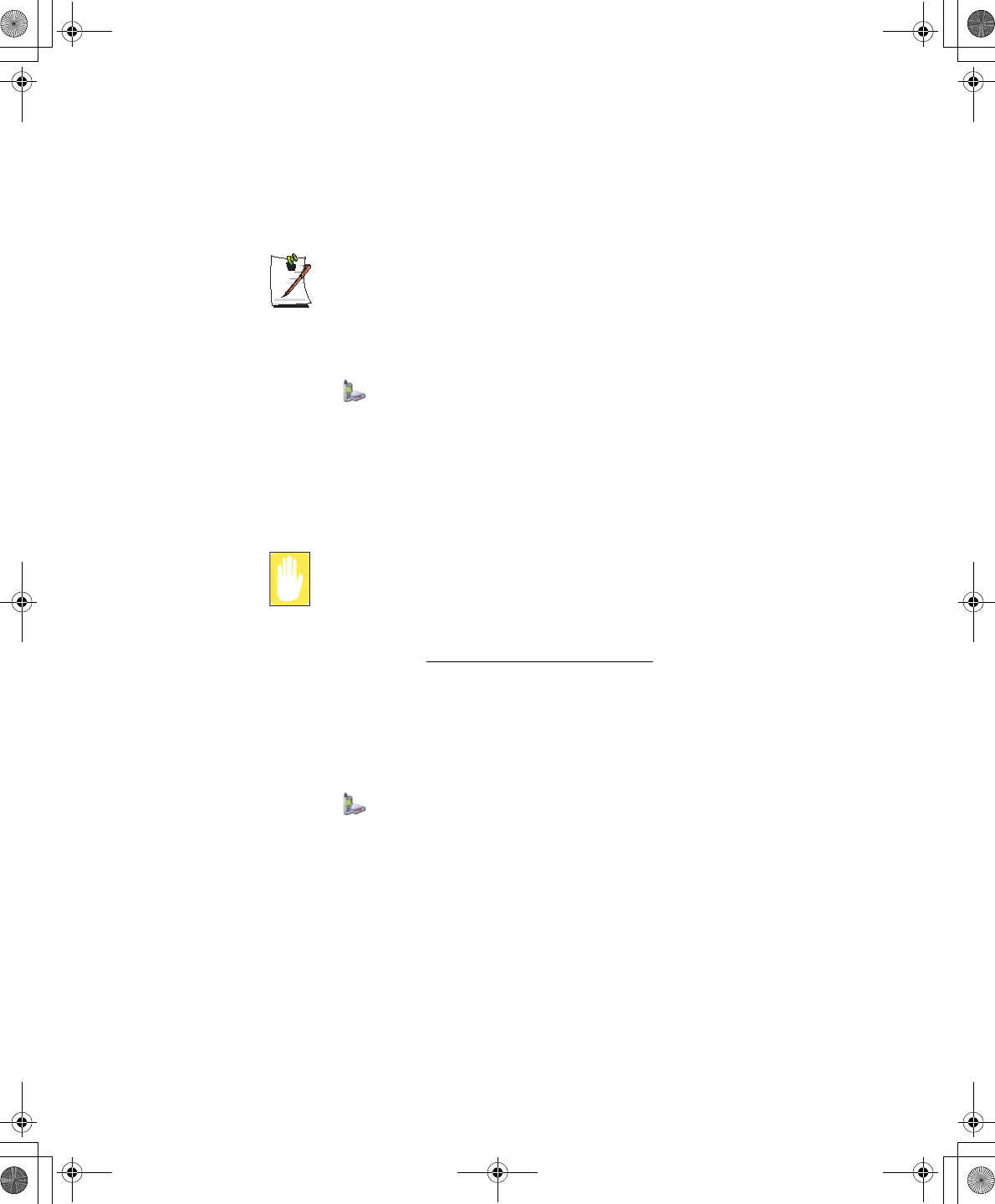
22 Users Manual
Precautions Before Use
Country Selection
Country Selection:
Because your computer is very mobile you must ensure you select the
country you are calling from is selected correctly, otherwise you may
experience connection problems.
To change the country selection proceed as follows:
1. Click Start > Control Panel > Network and Internet Connections.
2. Click Phone and Modem Options.
3. Click on the connection you wish to edit in the Locations: box.
4. Click Edit in the Dialing Rules Tab
5. Select the Country/region you are calling from in the General tab.
6. Click OK to close the “Edit Locations” box.
7. Click OK to close “Phone and Modem Options” box.
Digital Phone Lines:
If you connect the modem to a digital phone line (such as a company
4-wire system), the modem may be damaged.
DOS support
•Windows XP: Does not support pure DOS mode and the modem does not
support a DOS box in Windows. So you cannot use a
communication application which runs under DOS.
Using the Modem on a PBX system
If you use a Windows Communication Program:
1. Click Start > Control Panel >Network and Internet Connections.
2. Click Phone and Modem Options.
3. Click Properties in the Modems tab section.
4. Check off “Wait for dial tone before dialing” check box in the Modem tab section.
5. Click OK to close the dialog box.
6. Click OK to close “Modem Properties” dialog box.
Taurus (Windows XP) - English.fm Page 22 Thursday, March 28, 2002 6:06 PM
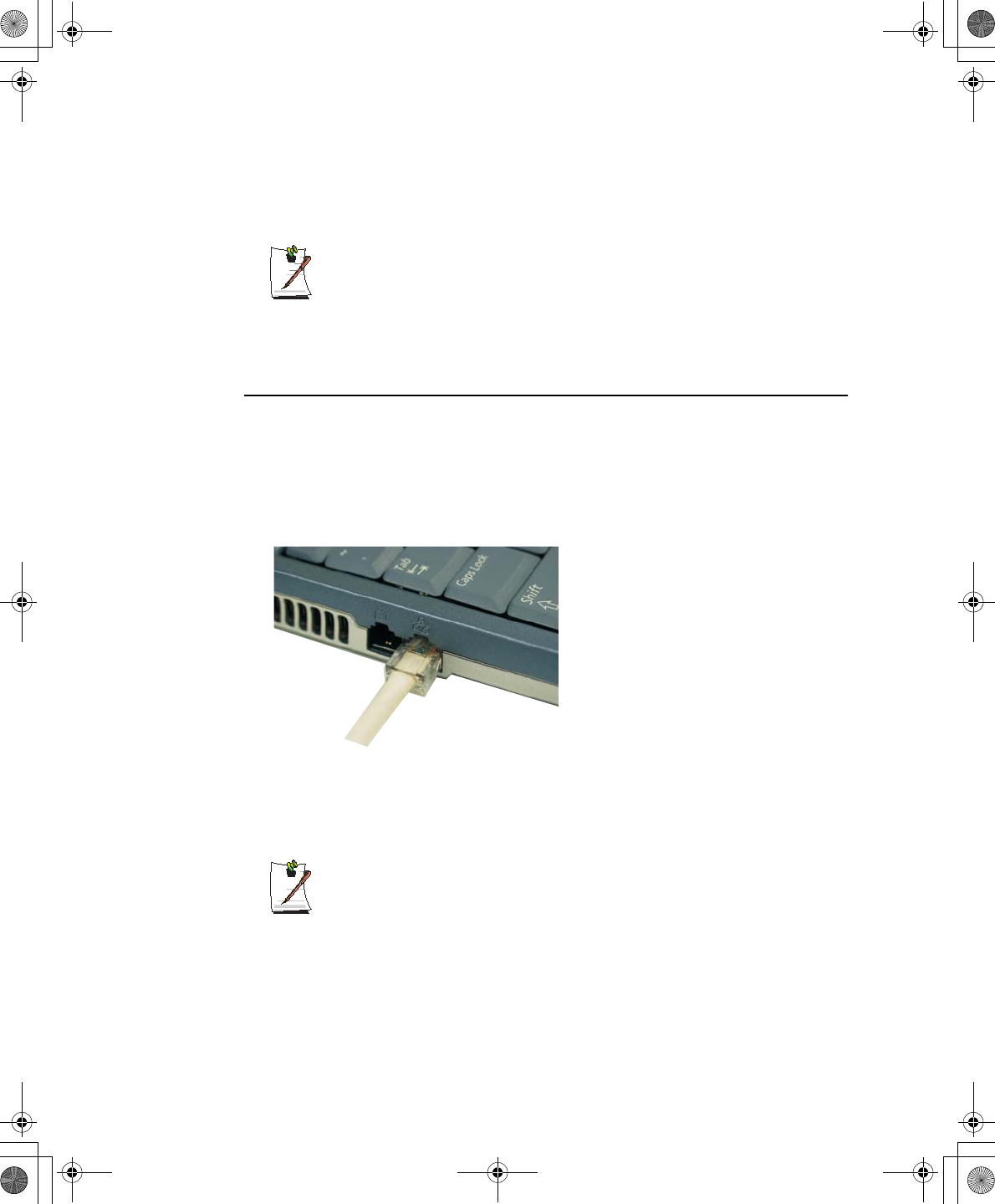
Connecting to the Internet 23
If you use a simple terminal program (i.e. hyper terminal):
Type the “ATX3&W” or “ATX3” command as an initialization command.
MODEM Notes:
1. In order to use the 56K feature, be sure to check if the standards supported
by the on-line service provider and the modem are identical.
2. If you use a PBX phone system, you can not connect using the 56K mode.
3. Internationally connected calls will be limited to 33.6K (Max.)
Using the LAN
You may connect to the network using either a LAN cable or by establishing a wireless
connection if factory option is installed.
Cable Connection
Install the LAN cable by simply plugging the cable into the slot in the left side of the
computer.
Your computer’s LAN adapter is ready to use for most situations, however if your
system does not have a DHCP server or you wish to personally configure your LAN
connection, proceed as outlined in “Configuring Network Environment” below.
Network Protocols:
You may need to consult your SysAdmin if their network protocols and settings
are required for your LAN environment.
Taurus (Windows XP) - English.fm Page 23 Thursday, March 28, 2002 6:06 PM
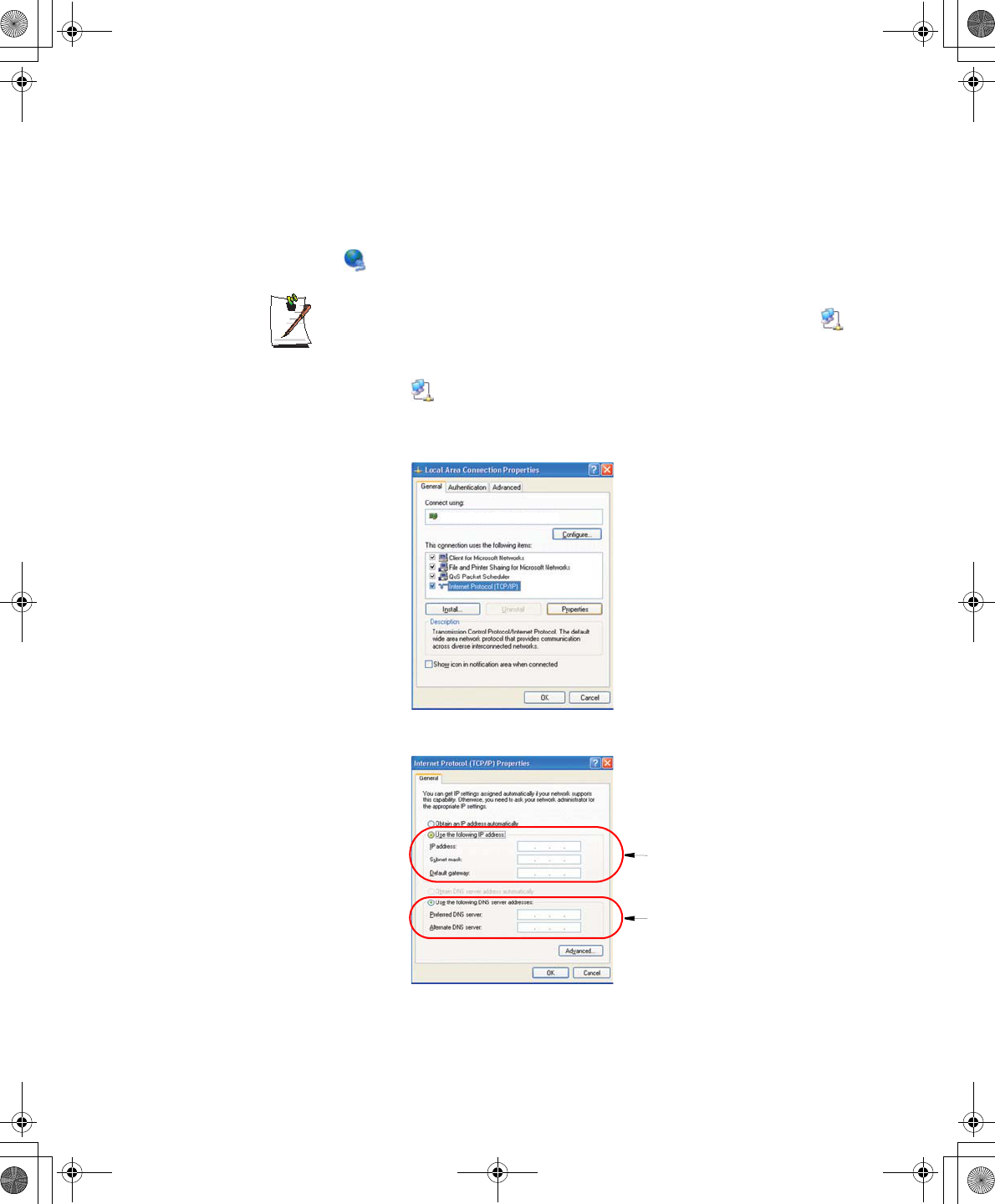
24 Users Manual
Configuring Network Environment
Configure the Network Adapter as follows:
1. Click Start > Control Panel > Network and Internet Connections
2. Click icon (Network Connections).
Configure Adapter Only (Not Connected to Network)
If your network is not active or the cable is NOT connected double click the
icon (Labeled Local Area Network) then follow the instructions starting with
step 4 below.
3. Right-Click the icon (Labeled Local Area Network) then click Properties
button.
4. Select Internet Protocol (TCP/IP) in the “This connection uses the following
items:” box.
5. Click Properties. The TCP/IP Properties window opens.
Intel(R) Pro/100 VE Network Connection
Step 7
Step 8
Taurus (Windows XP) - English.fm Page 24 Thursday, March 28, 2002 6:06 PM
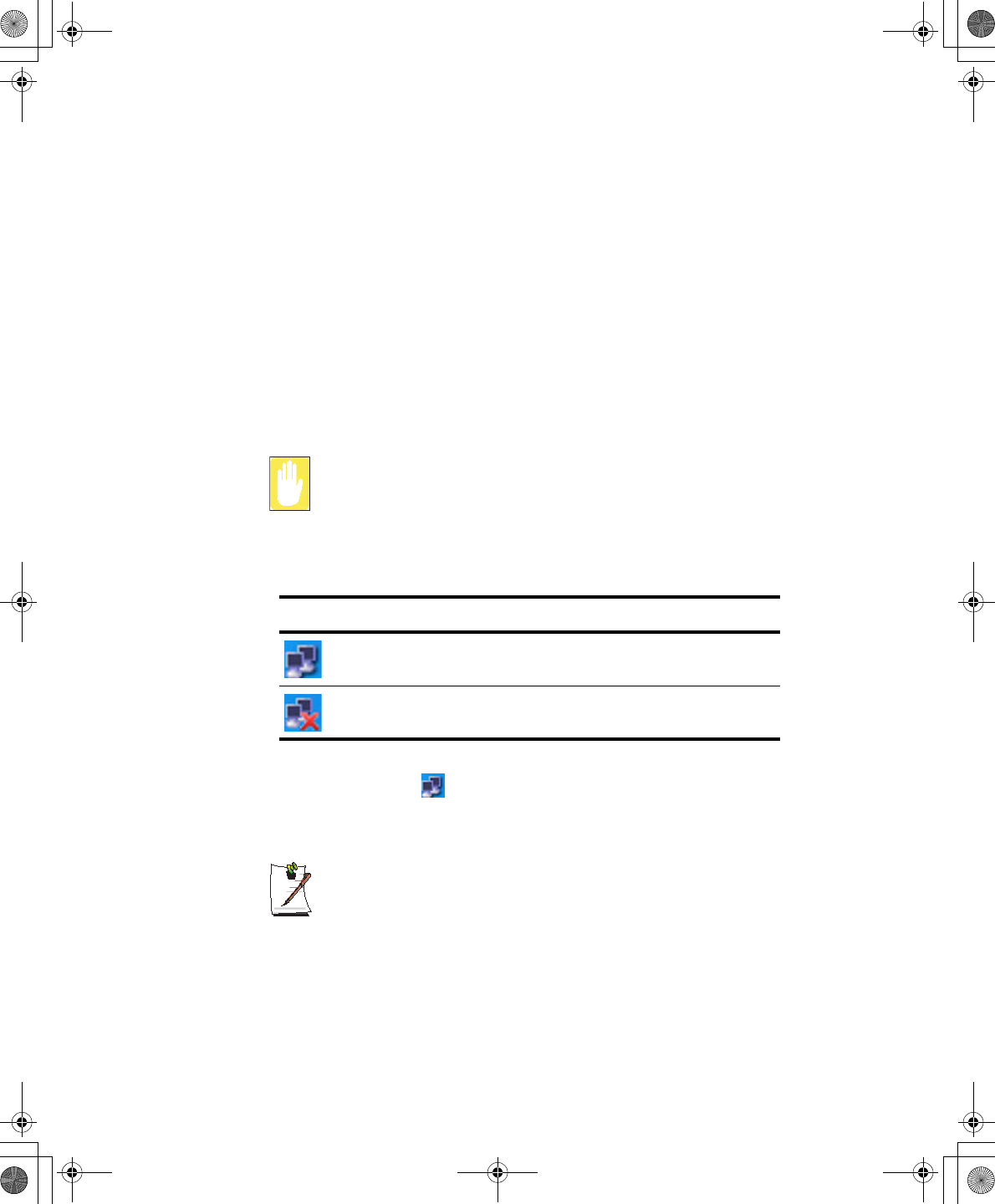
Connecting to the Internet 25
6. Click “Use the following IP address” in the General tab
7. In the “Use the following IP address” box, enter your IP address:, subnet mask:
and Default Gateway:.
8. In the “Use the following DNS server addresses” box, Enter your Preferred DNS
server: and Alternate DNS server:.
9. Click OK when you finish the TCP/IP set-up.
Wireless Connection (Factory Option)
Your computer’s wireless LAN adapter is ready to use for most situations, however if
your system does not have a DHCP server or you wish to personally configure your
wireless LAN connection, proceed as outlined in “Configuring Network Environment”
below.
FCC statement for Wireless LAN use:
“While installing and operating this transmitter and antenna combination the
radio frequency exposure limit of 1mW/cm2 may be exceeded at distances
close to the antenna installed. Therefore, the user must maintain a minimum
distance of 20cm from the antenna at all times. This device can not be co-
located with another transmitter and transmitting antenna.”
The table below shows the Windows taskbar icons for the wireless LAN.
To display relative Signal Strength:
1. Double Click the icon in the taskbar to display the Wireless Network
Connection Status window. This window also displays connection Status, Speed,
Duration and Activity.
Network Protocols:
You may need to consult your System Administrator if their network protocols
and settings are required for your wireless LAN environment.
Icon Name Description
Connection
Established
Displays if connection is available.
Connection
Unavailable
Displays if connection is unavailable.
Taurus (Windows XP) - English.fm Page 25 Thursday, March 28, 2002 6:06 PM
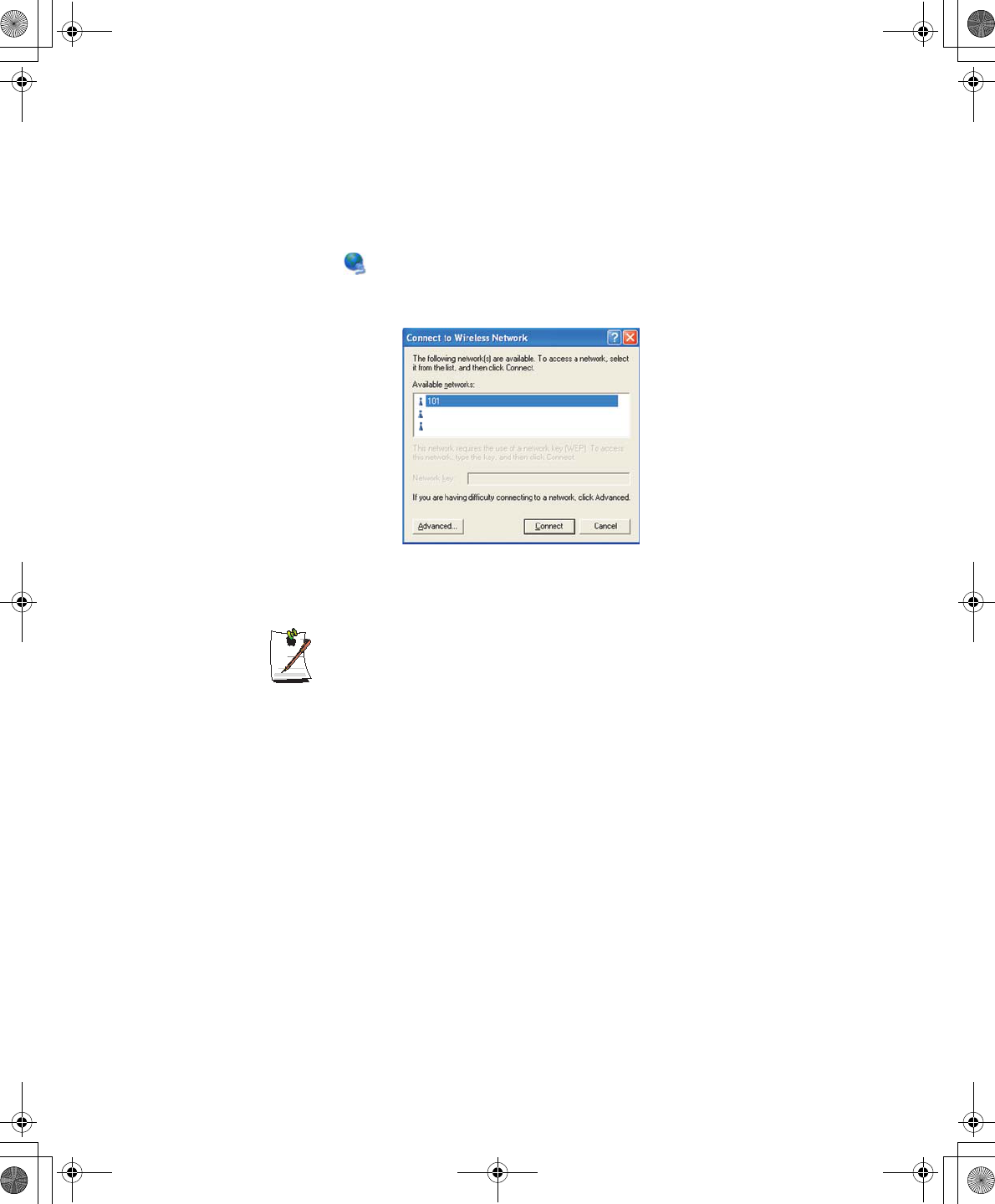
26 Users Manual
Configuring Network Environment
Configure the Wireless Network Adapter as follows:
1. Click Start > Control Panel > Network and Internet Connections
2. Click icon (Network Connections)
3. Double-Click the Wireless Network Connection icon. The Connect to Wireless
Network window pops up.
4. Select one of the available networks in the Available networks section, if
displayed.
No networks are displayed
Office - Consult your system administrator.
Home - Verify your access point is working properly.
5. Click the Connect button. The Wireless Network Connection icon in the control
panel will show your connection is Enabled. You may proceed using the network
as normal wired LAN connections.
Change Wireless Network Access Point as follows:
1. Right Click the Wireless Network Connection icon.
2. Click View Available Wireless Networks. The Connect to Wireless Network
window pops up.
3. Select the new network from the available networks in the Available networks
section, if displayed.
4. Click Connect button. The Wireless Network Connection icon in the control panel
will show your connection is Enabled. You may proceed using the network as
normal wired LAN connections
General Office Net
Supervisor Office Net
Taurus (Windows XP) - English.fm Page 26 Thursday, March 28, 2002 6:06 PM
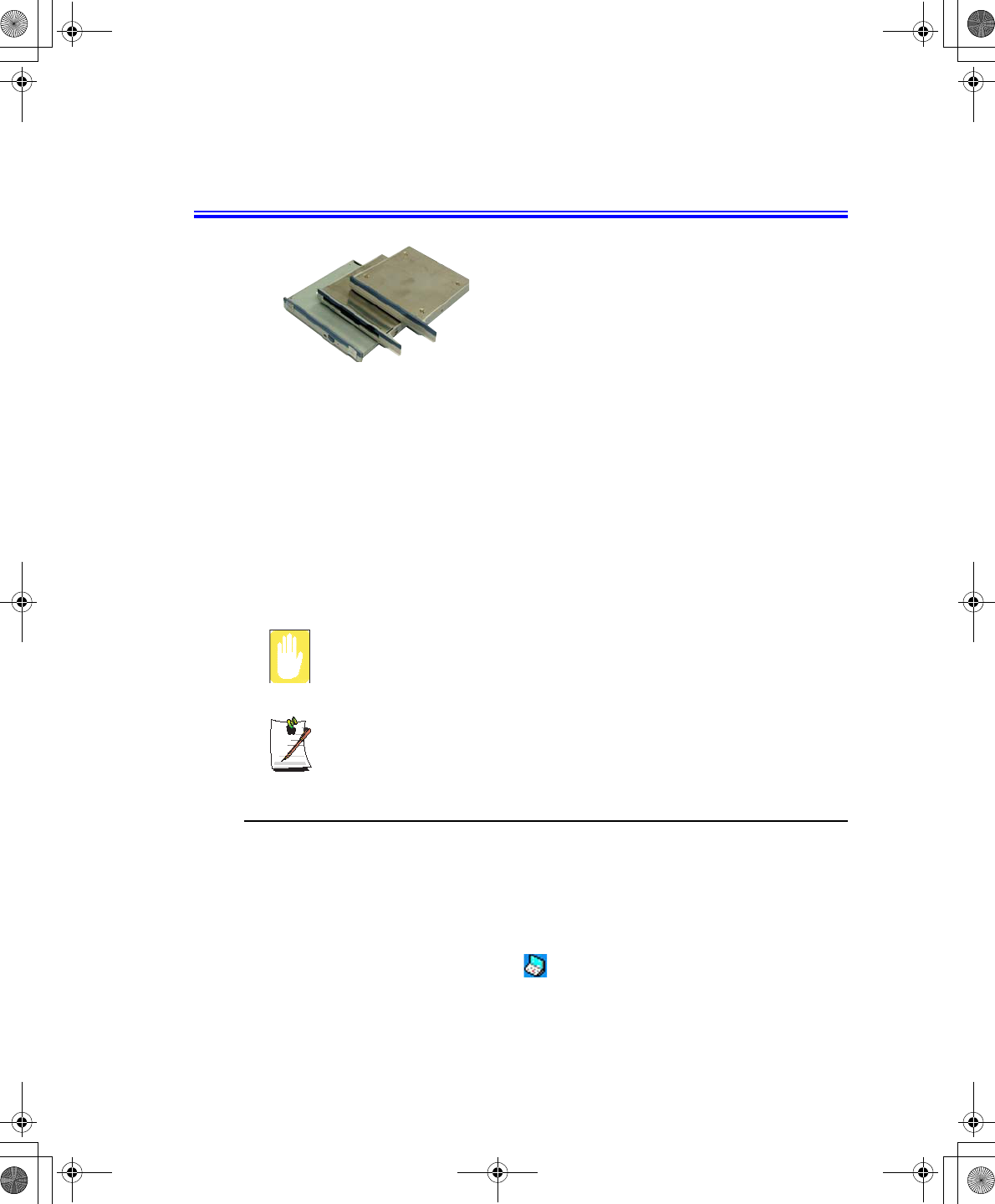
Using the Flex-Bay 27
Using the Flex-Bay
If your operating system is Windows, you must install the Softex Bay Manager
software on the software CD in order to use the Bay Manager Utility to hot-
swap the devices.
If you do not use Windows, make sure that the computer’s power is off before
you remove or install any devices.
Swap a Flex-Bay Device - Power On
You can use the Softex Bay Manager utility to hot-swap your devices in the flex-bay.
To start the Softex Bay Manager utility:
1. Click Start >Control Panel > Other Control Panel Options > Softex Bay
Manager.
- or -
2. Double-Click the SwapBay icon in the Windows taskbar.
The Flex-Bay provides an impressive array of
secondary storage devices listed below:
CD-ROM drive:
Shipped with some computers is also an available option.
CD-ROM R/W drive:
Shipped with some computers is also an available option.
DVD-ROM drive:
Shipped with some computers is also an available option.
DVD/CD-RW Combo drive:
Shipped with some computers is also an available option.
Optional secondary hard drive:
Available as an option for your computer.
Taurus (Windows XP) - English.fm Page 27 Thursday, March 28, 2002 6:06 PM
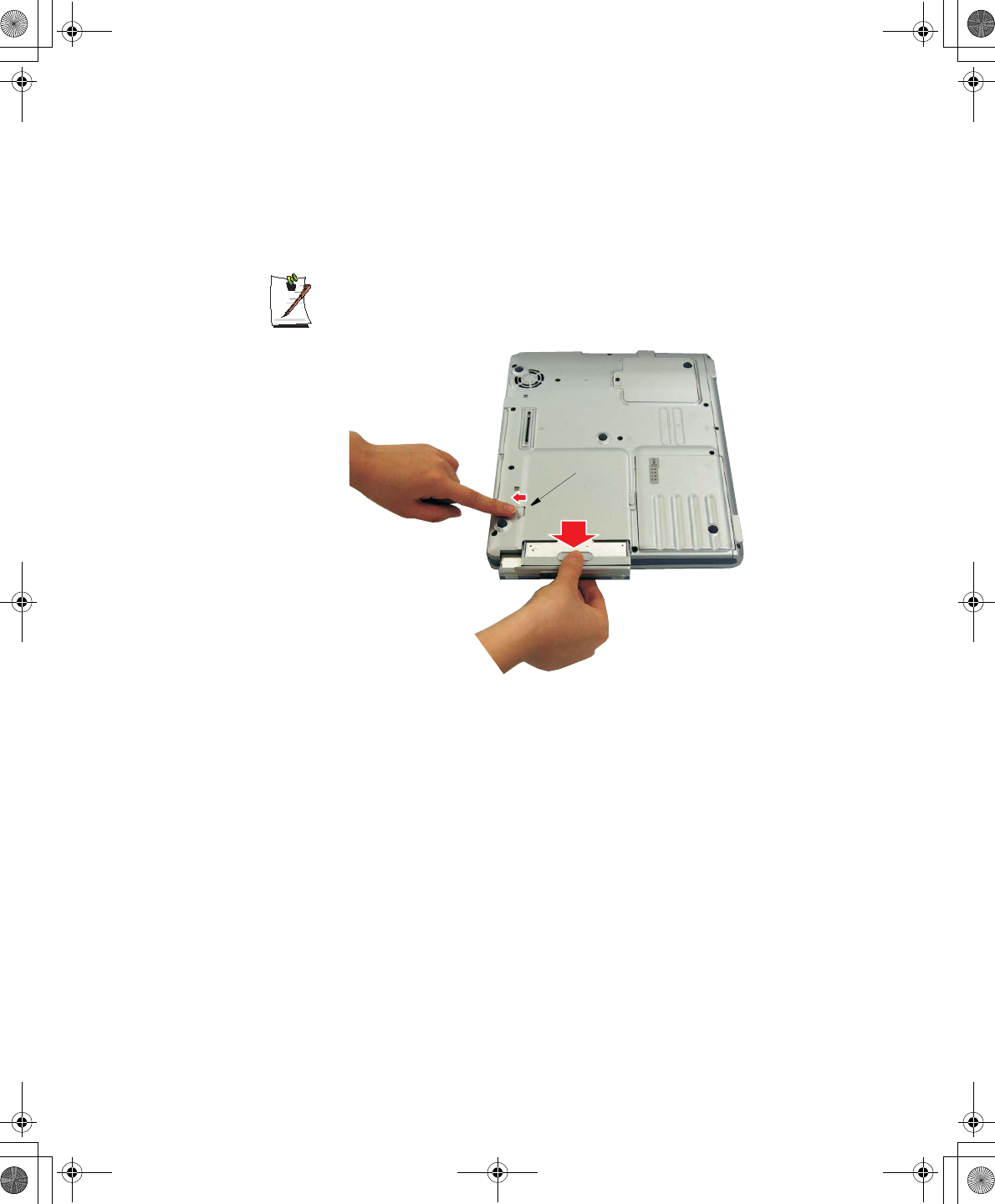
28 Users Manual
Device Swap
To swap a device with the power on proceed as follows:
1. Start the Softex Bay Manager Utility.
You do not have to turn the computer over or tip it on its side to change
devices. Simply tilt the computer up about 10 cm at the back and locate the
Flex-Bay latch. See Figure below for the location of the Flex-Bay latch. The
computer in the figure is turned over for clarity.
2. Click Remove / Swap. A Device Change popup window stating, “Please wait until
the system processes the device change” appears then another popup window
appears and says, “Please remove or swap your bay device(s) now and press OK.”
3. Tilt the computer up & locate the smart bay latch.
4. Slide and hold the device latch toward the rear of the computer.
5. Slide the device out.
6. Slide the new device in
7. Click OK. The message “Please wait until the system processes the device
change” appears again.
8. Click OK to close the Softex Bay Manager Utility.
Flex-Bay Latch
Taurus (Windows XP) - English.fm Page 28 Thursday, March 28, 2002 6:06 PM

Using the Flex-Bay 29
Swap a Flex-Bay Device - Power Off
Device Swap
To remove a device with the power off proceed as follows:
1. Turn the computer’s power off.
2. Tilt the computer up & locate the smart bay latch.
3. Slide and hold the device latch toward the rear of the computer.
4. Slide the device out.
5. Carefully slide the new device into the bay.
6. Push the device in until it is flush with the chassis and the Flex-Bay latch snaps
into place. Your computer’s operating system automatically recognizes the device
in the Flex-Bay and configures your computer accordingly when power is restored.
Taurus (Windows XP) - English.fm Page 29 Thursday, March 28, 2002 6:06 PM
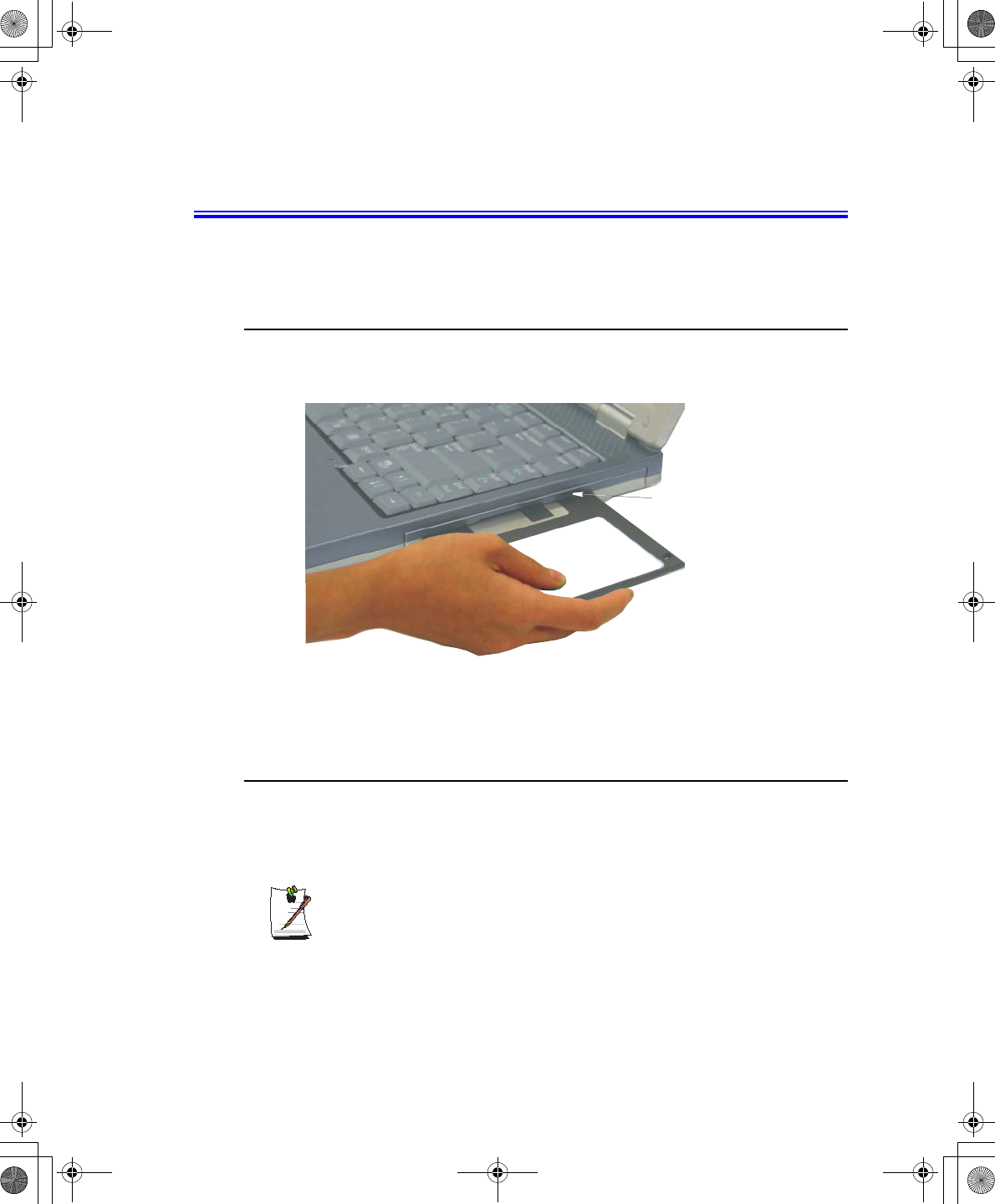
30 Users Manual
Using the Disk Drives
To use the Floppy drive or the CD-ROM drive you must verify it is installed in the
flexbay slot. To swap devices see “Using the Flex-Bay” on page 27.
Using the Floppy Disk Drive
Your computer comes with a 1.44 MB, 3.5-inch, floppy drive.
To use a floppy disk in your computer, insert it into the floppy drive.
To remove a floppy disk, press the floppy disk eject button on the front of the floppy
drive.
To protect the data on your floppy disks, follow the manufacturers guidelines.
Using the CD/DVD-ROM Drive
Compact discs are designed so that you can easily insert one into the computer when
you need it, and then remove it. See ”Using the Flex-Bay” on page 27 for information
on installing the DVD-ROM drive into the computer.
DVD Notes:
A DVD player is a factory option and if you ordered this option you will have to
install the provided DVD software to view the DVD Title.
Floppy Disk Eject Button
Taurus (Windows XP) - English.fm Page 30 Thursday, March 28, 2002 6:06 PM
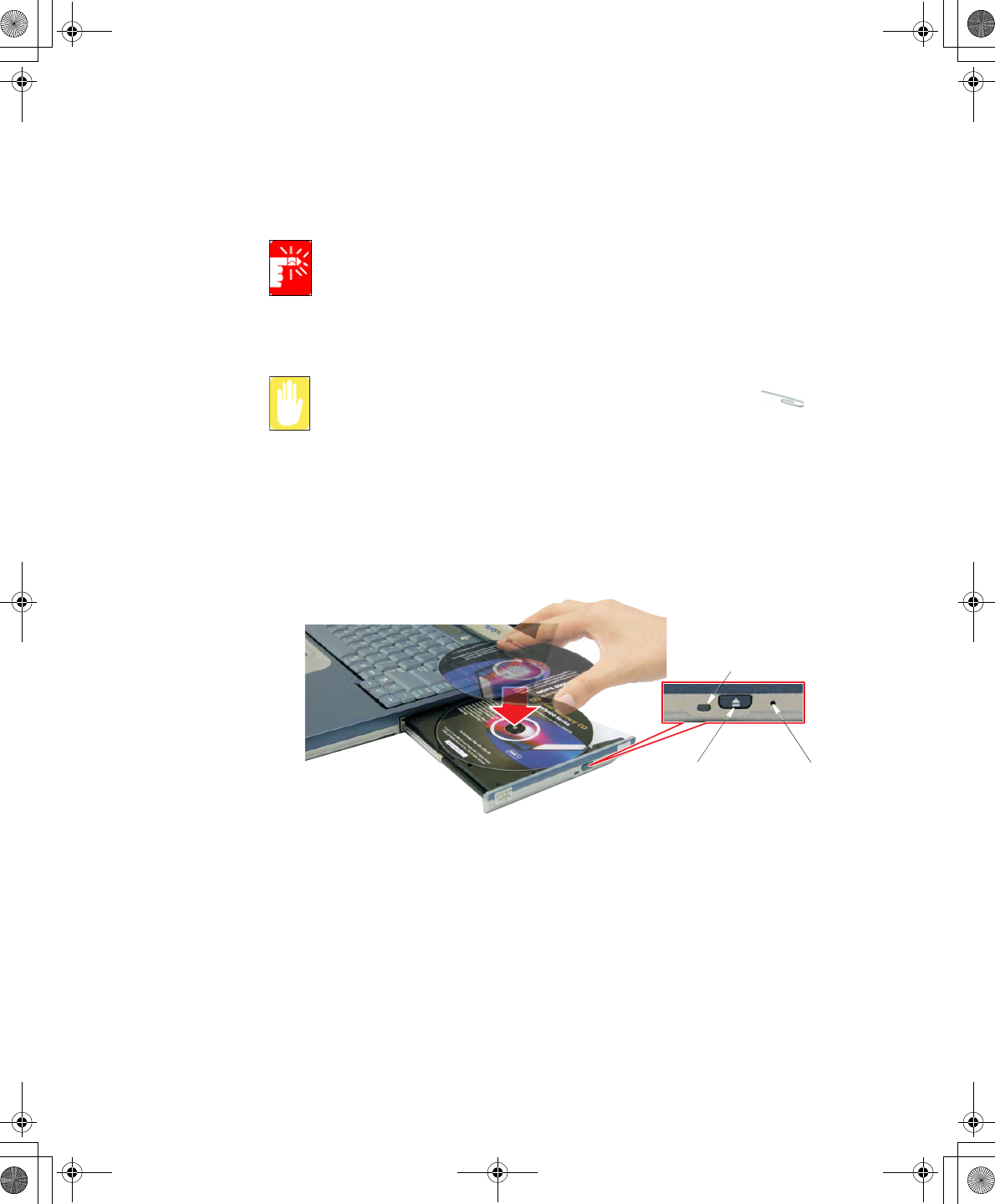
Using the Disk Drives 31
1. Press the button on the CD-ROM or DVD-ROM drive, and the tray slides out.
(Do not lean on the tray; because it will not support much weight.)
CD/DVD Drive Warnings:
Do not place reflective objects other than the CD/DVD disks in the disk slot
because of possible hazardous laser emissions. The laser beam used in this
CD/DVD-ROM drive is harmful to the eyes. Do not attempt to disassemble the
CD/DVD-ROM drive. Refer servicing to your authorized service center.
Do not touch the CD/DVD lens, doing so may damage the device.
CD/DVD Precautions:
The tray may be stuck, in which case straighten out a paper clip, insert
it into the Emergency Eject hole in the front of the CD/DVD-ROM and push it
until the tray ejects.
A LED on the drive tray is on when the computer is reading from a CD. Do not
remove a disc when this LED is on.
To clean a CD/DVD, wipe from the center outwards with clean and dry cloth.
Remove the CD/DVD when the drive activity LED is off.
2. Insert a CD/DVD, label side up (or remove a disc, if you have finished using it).
3. Push the tray in gently to close the drive tray.
Install and/or start a CD-based program as you would run a program on a floppy disk.
Eject Button
CD-ROM Light
Emergency
Eject Button
Taurus (Windows XP) - English.fm Page 31 Thursday, March 28, 2002 6:06 PM
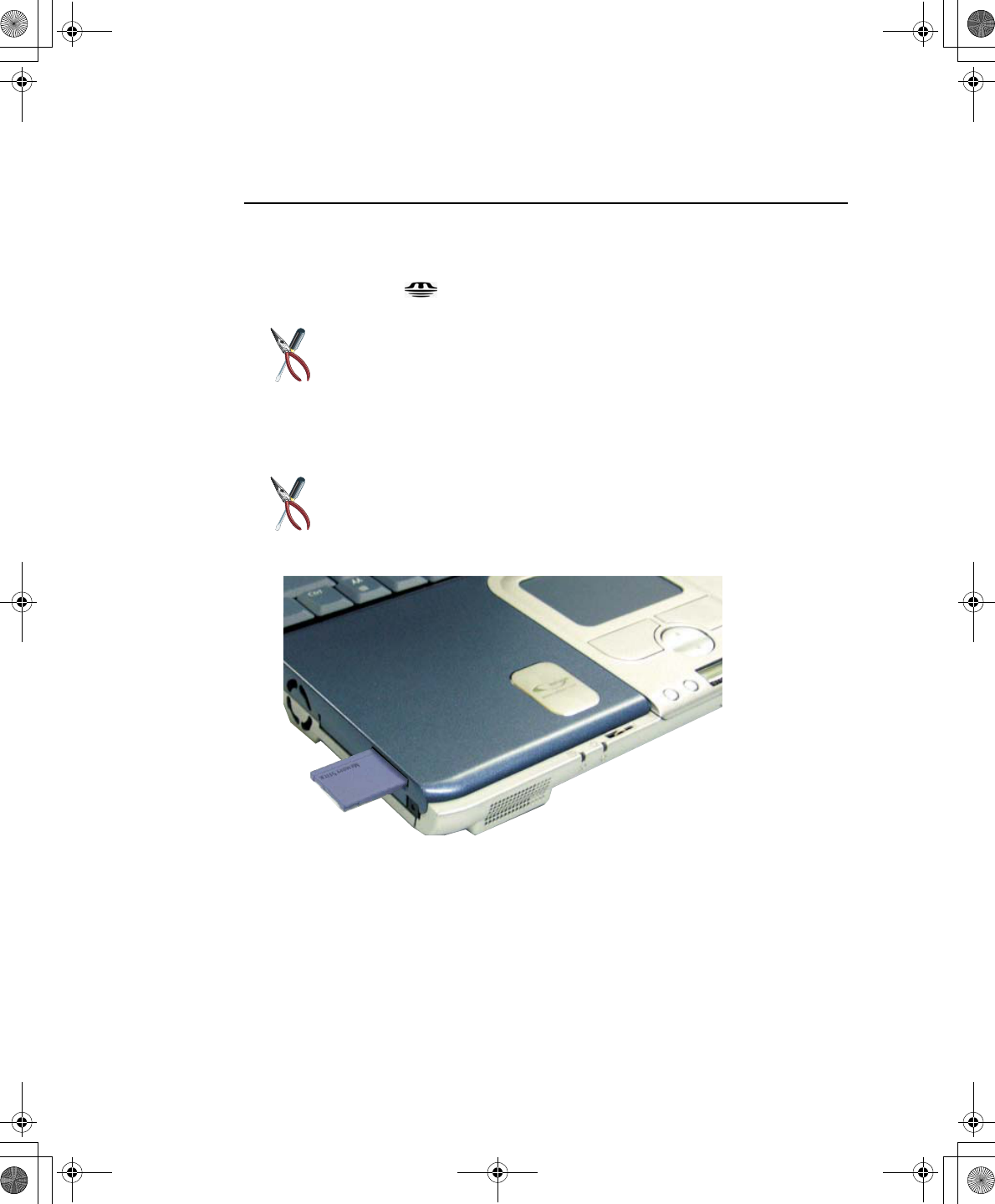
32 Users Manual
Using the Memory Stick (Factory Option)
The Memory Stick is a factory option that will increase your computer storage capacity as well
as increase data portability. The Memory Stick may used in many types of equipment such as
digital cameras and PDAs for example.
Memory Stick and are a trademarks of the Sony Corporation.
Memory Stick Support
The Magic Gate model is not currently supported.
Inserting the Memory Stick
To insert the memory stick proceed as follows:
Ensure you Insert the Memory Stick into the slot with the correct orientation
(Name Up) so that the Memory Stick will operate properly and be recognized
by the computer.
1. Slide the Memory stick into the slot until you feel the first latch catch.
2. Then push the Memory stick in until it clicks into place.
Taurus (Windows XP) - English.fm Page 32 Thursday, March 28, 2002 6:06 PM
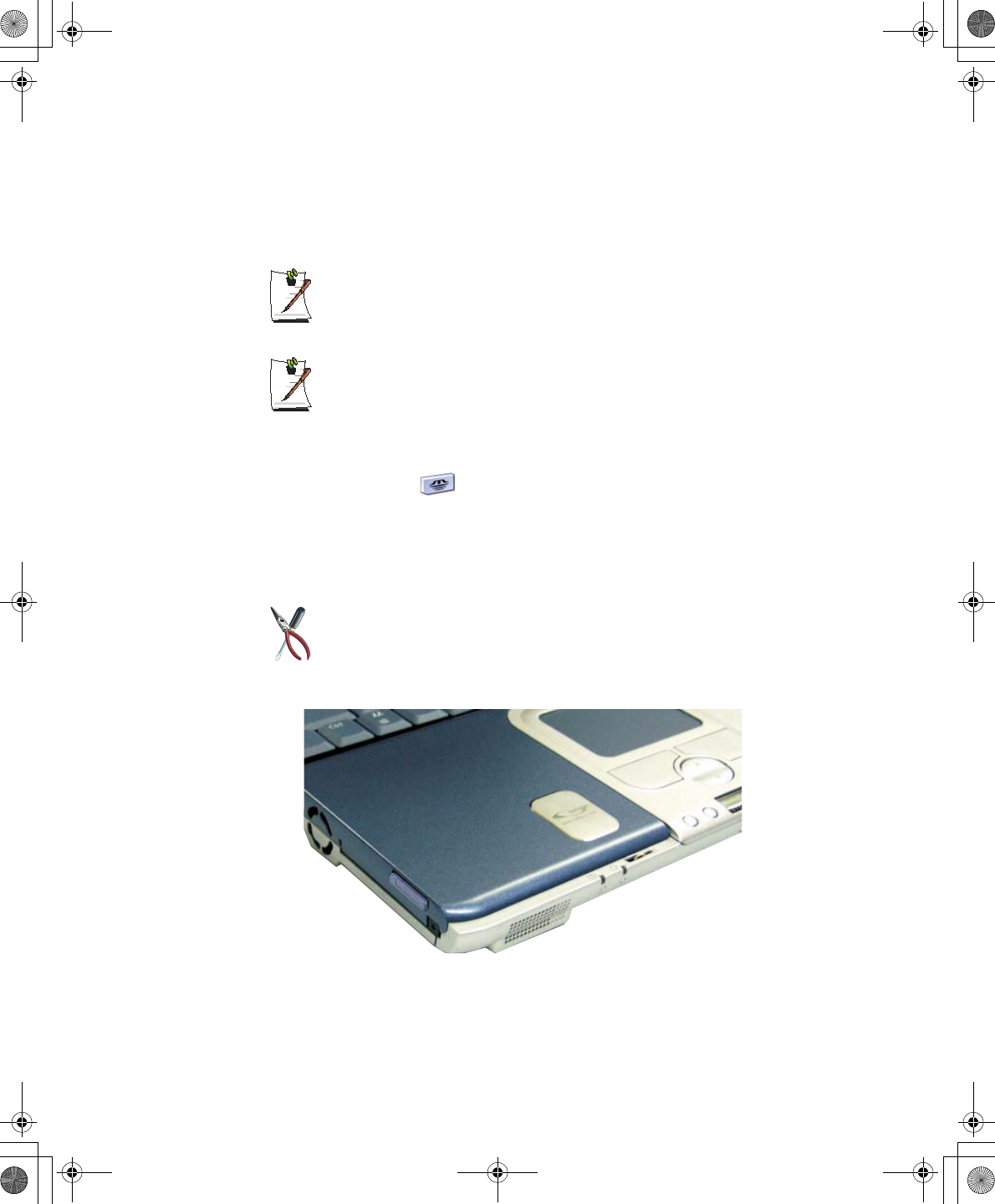
Using the Disk Drives 33
Using the Memory Stick
The Memory Stick is used the same as the FDD drive on your computer but with much
larger capacity, currently up to 128MB.
Formatting the Memory Stick
The Memory Stick may need to be formatted before use, if so insert it into the
slot and format it the same as the FDD Drive.
Protecting Data on the Memory Stick
To prevent overwriting/deleting your data in the Memory Stick, move the slide
lock to the “Lock” position.
to see the contents of the Memory Stick:
1. Double Click “My Computer” on the desktop, the My Computer window opens.
2. Double Click the icon in the Devices with Removable Storage section of the
window.
Removing the Memory Stick
To use the Memory Stick proceed as follows:
Ensure any operations using the Memory stick have completed before you
remove it. Otherwise you will corrupt your data.
1. Push the Memory Stick in until it clicks and release.
2. The Memory Stick will pop out ~ 1 cm and then you can slide it out.
Taurus (Windows XP) - English.fm Page 33 Thursday, March 28, 2002 6:06 PM